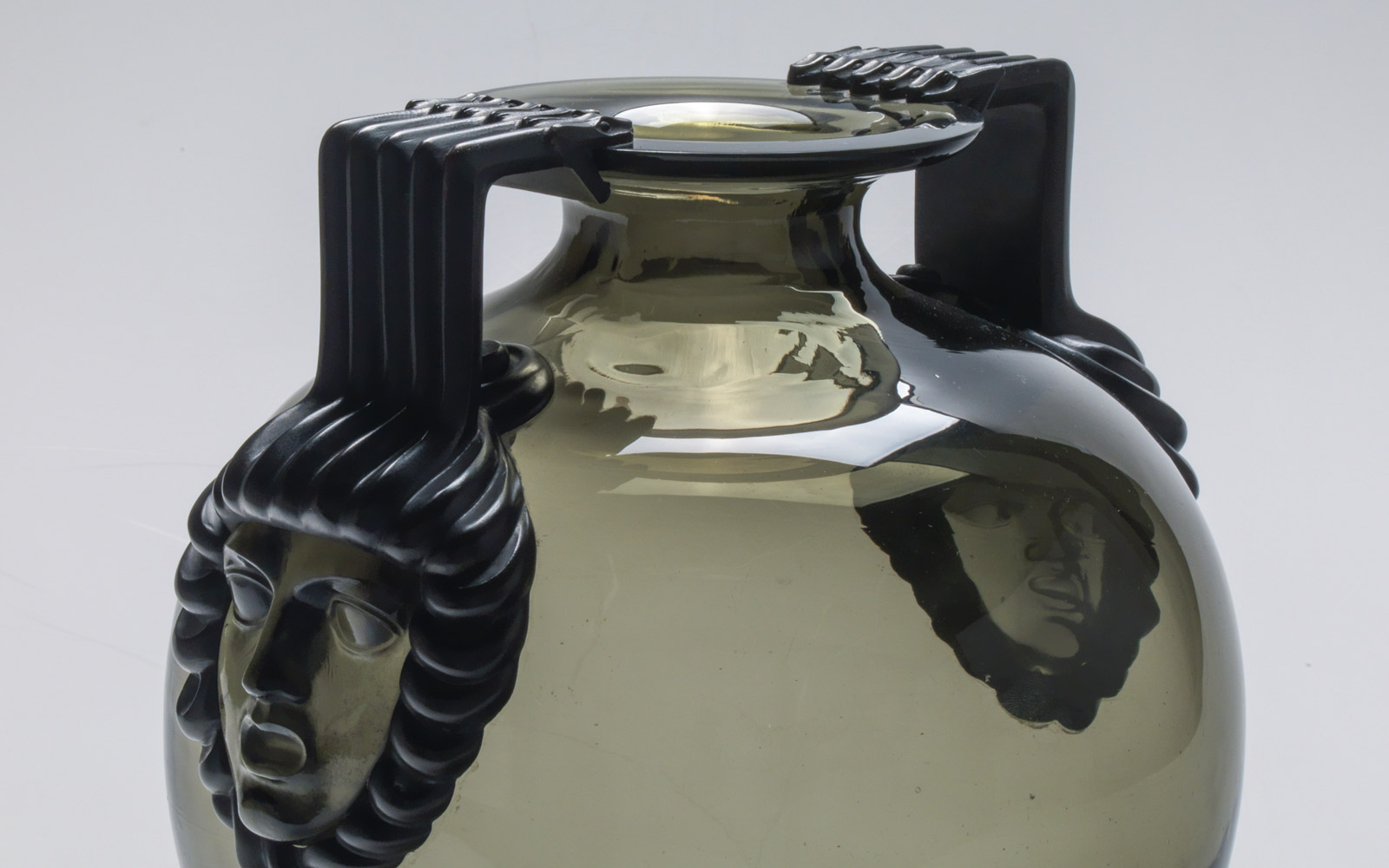
René Lalique and the Age of Glass
Art and Industry
Event Slider
Date
- Closed on Tuesday
Location
Founder’s Collection – Lower Gallery Av. de Berna, 45A, Lisbon Maximum capactity: 25 visitorsIn the Founder’s Collection, the Calouste Gulbenkian Museum has gathered almost two hundred works by René Lalique, including some of the most celebrated jewels created by this artist.
This magnificent set has its origins in the 1890s when Calouste Gulbenkian and René Lalique first met. Their friendship, which lasted for almost half a decade, led the collector to acquire all these pieces, with just one exception, directly from the artist between 1899 and 1927.
This exhibition, chronologically situated between two key moments in 20th century art history – the 1900 World Exhibition and the International Exhibition of Modern Decorative and Industrial Arts in 1925 – will cover the various stages of the artist’s career, from his jeweller days during the Art Nouveau period to the moment he took up the role of ‘creator-industrialist’, committing himself exclusively to glass as a material of creation.
Following the founding of a glass factory in Wingen-sur-Moder in the Alsace region, in 1922, inspired by the idea of ‘l’art pour tous’, as proposed by Roger Marx, Lalique diversified and developed his glass production, pointing to a new direction: the large-scale production of glass objects and the widespread use of glass in architecture and design.
The first exhibition dedicated by the Foundation to René Lalique since 1988 brings together of around one hundred works – including jewellery, vases, decorative panels and everyday objects –, revealing how the search for transparency was a perennial presence in the artist’s production.
For this project, the Calouste Gulbenkian Museum has enjoyed exceptional collaboration from the Musée Lalique in Wingen-sur-Moder, while also welcoming works from some of the most important private collections in the world. These works mainly illustrate the different stages in the artist’s career during the transition towards the mass production objects in the Art Déco period.
Curator: Luísa Sampaio
VIEW OF THE EXHIBITION

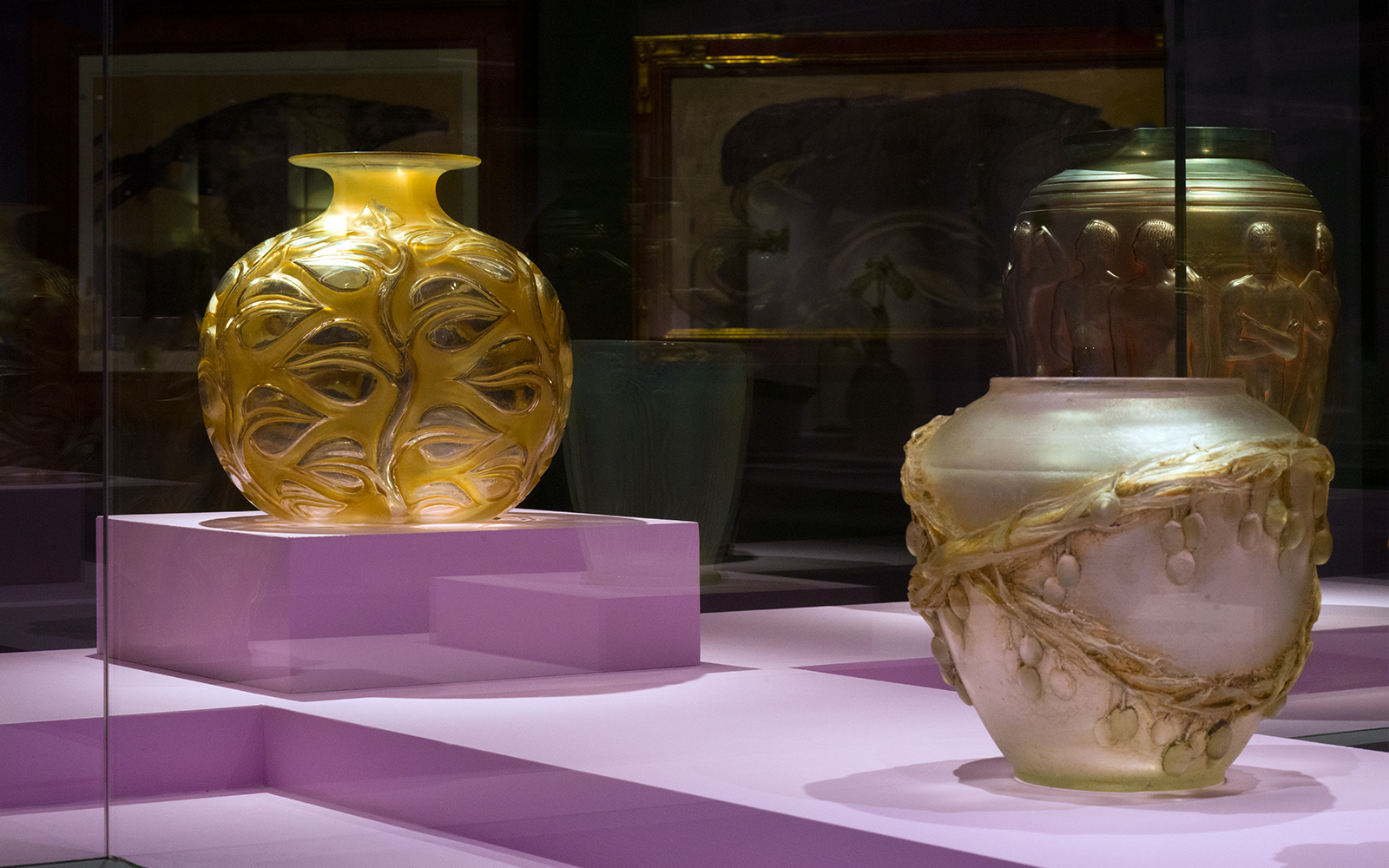
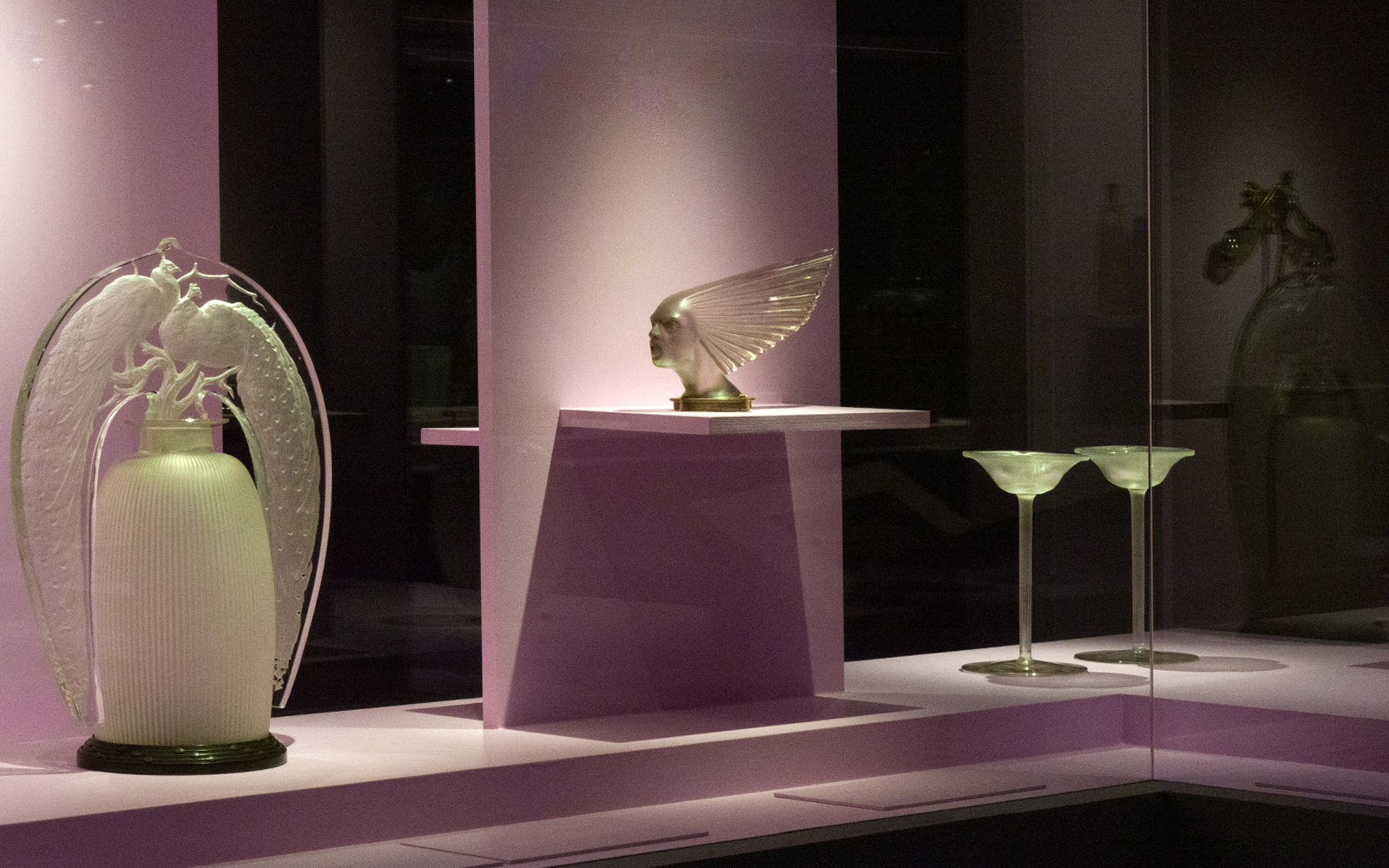
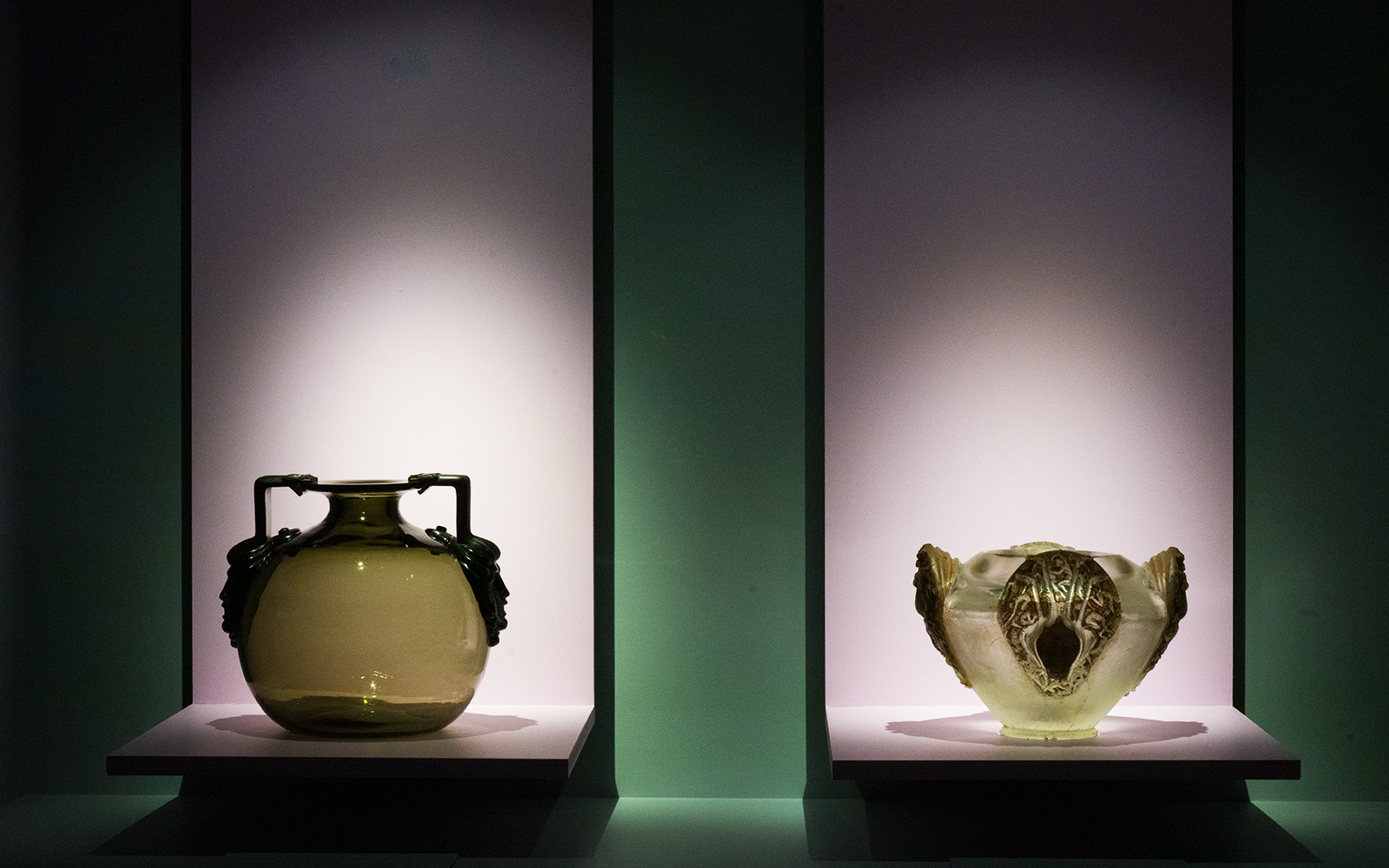
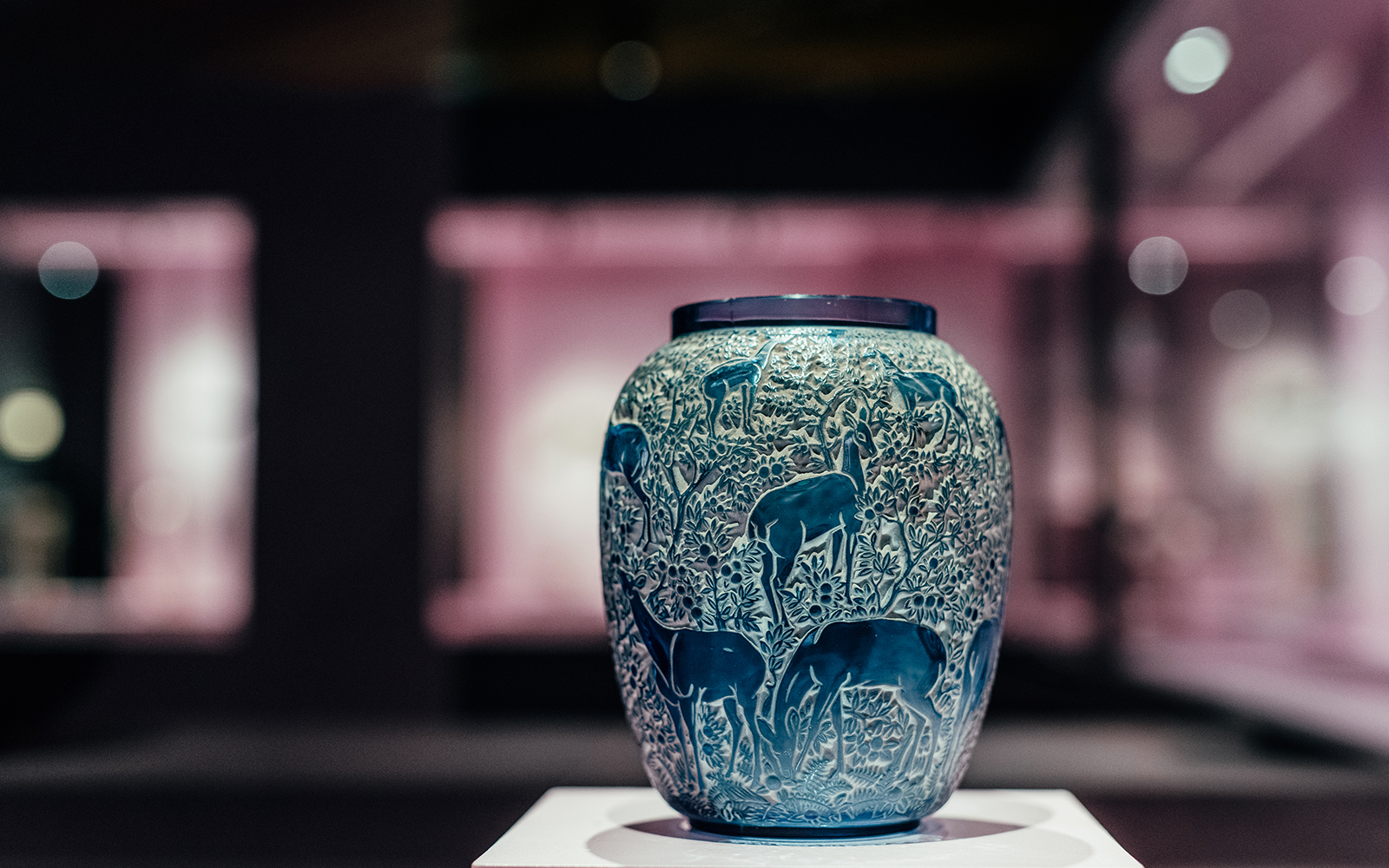
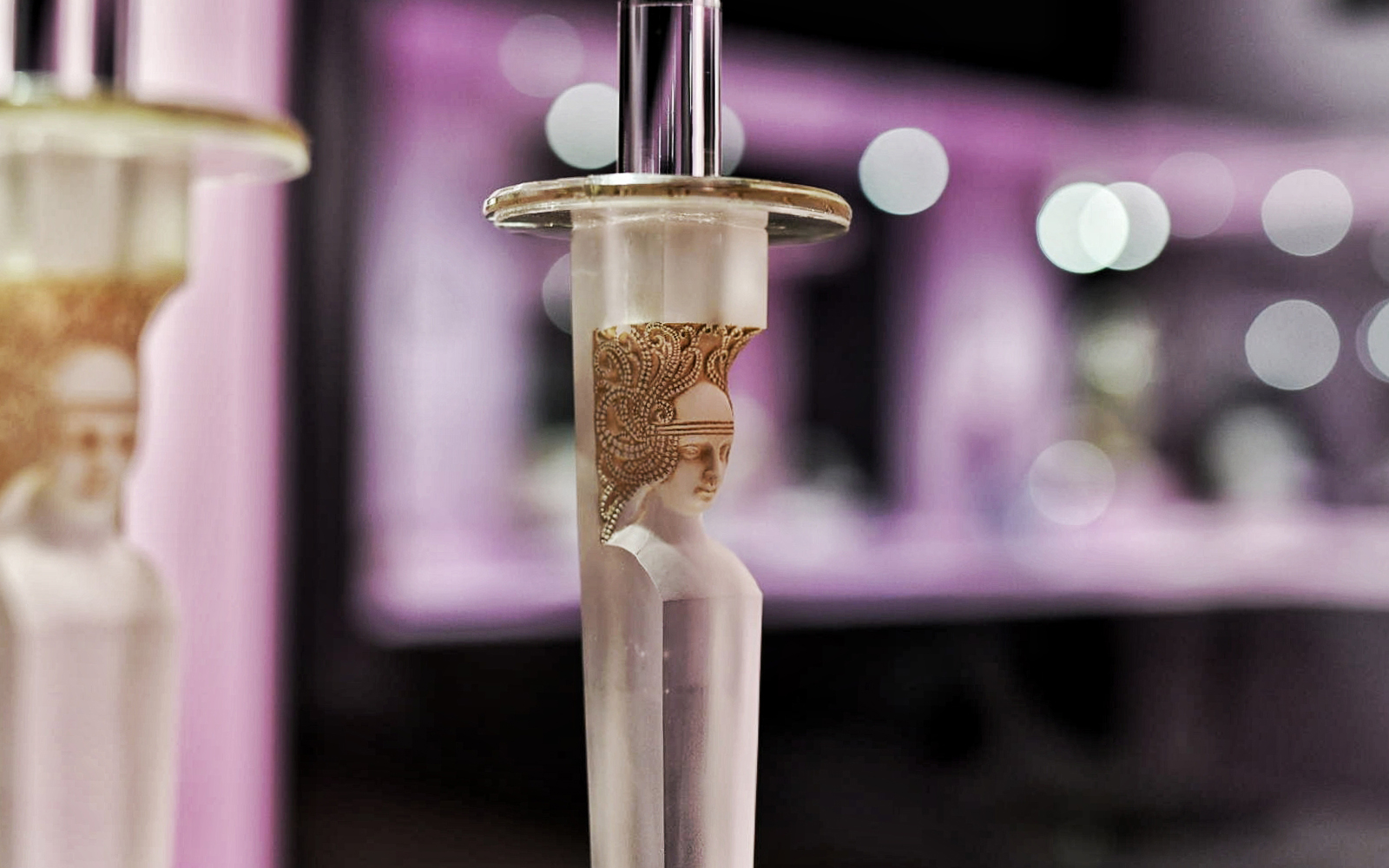

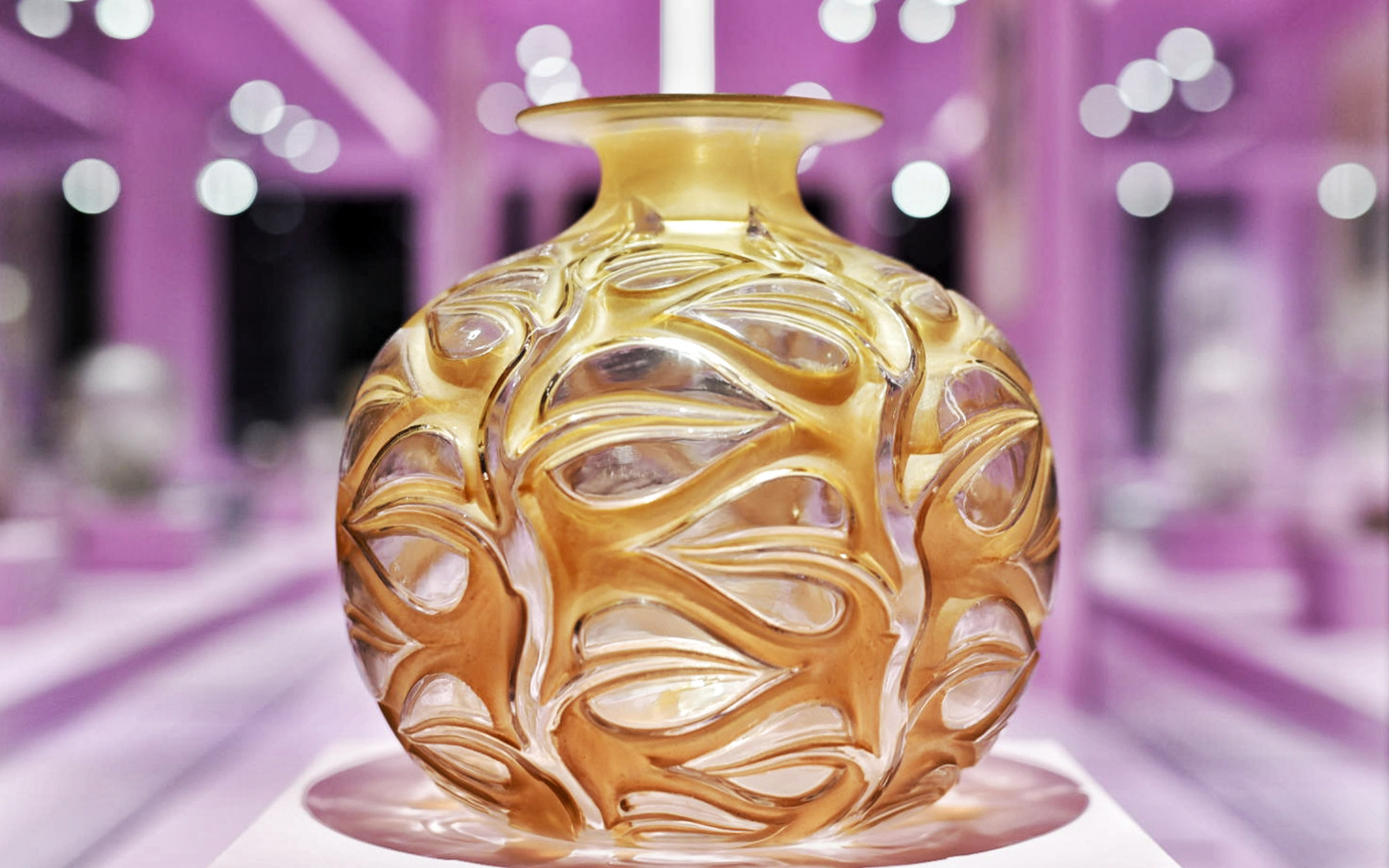
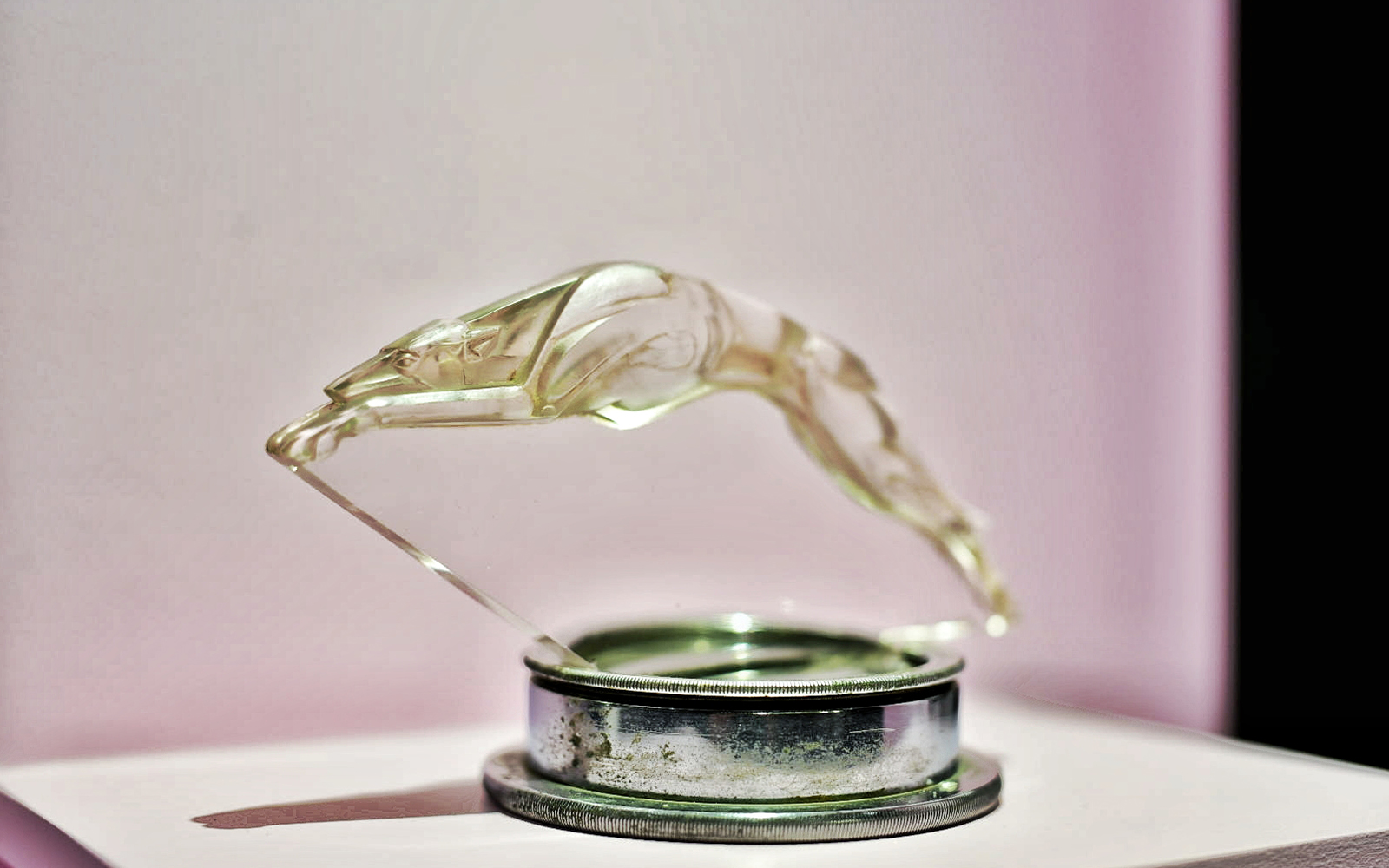
360º virtual tour
VIDEOS
Guided tour with curator Luísa Sampaio
René Lalique, the inventor of modern jewellery
Lost wax casting
‘Glass, the wonderful material’
Modern perfume
Travels and symbols of modernitye
Topics


Lost-wax castings

Industrial production

Architecture

Design

'Objets d’Art'

The invention of modern perfume
-
Jewellery with glass elements
Gulbenkian bought almost all the works in this section of the Founder’s Collection directly from Lalique. By 1912, when the artist held his final jewellery exhibition in his shop in Place Vêndome, in Paris, Calouste Gulbenkian had already purchased 69 of his pieces, exceptional examples of René Lalique’s originality and creativity.
The artist was known for designing jewellery made from innovative materials rather than precious stones. Glass was one of his favourite materials and he worked with it until the end of his career.
In his collection, Gulbenkian amassed a total of 82 pieces of Lalique jewellery, which he kept in purpose-made display cases, regarding them as works of art rather than everyday objects. Of these 82 pieces, 20 include glass elements, used either as the main material of the object or to create small decorative details.
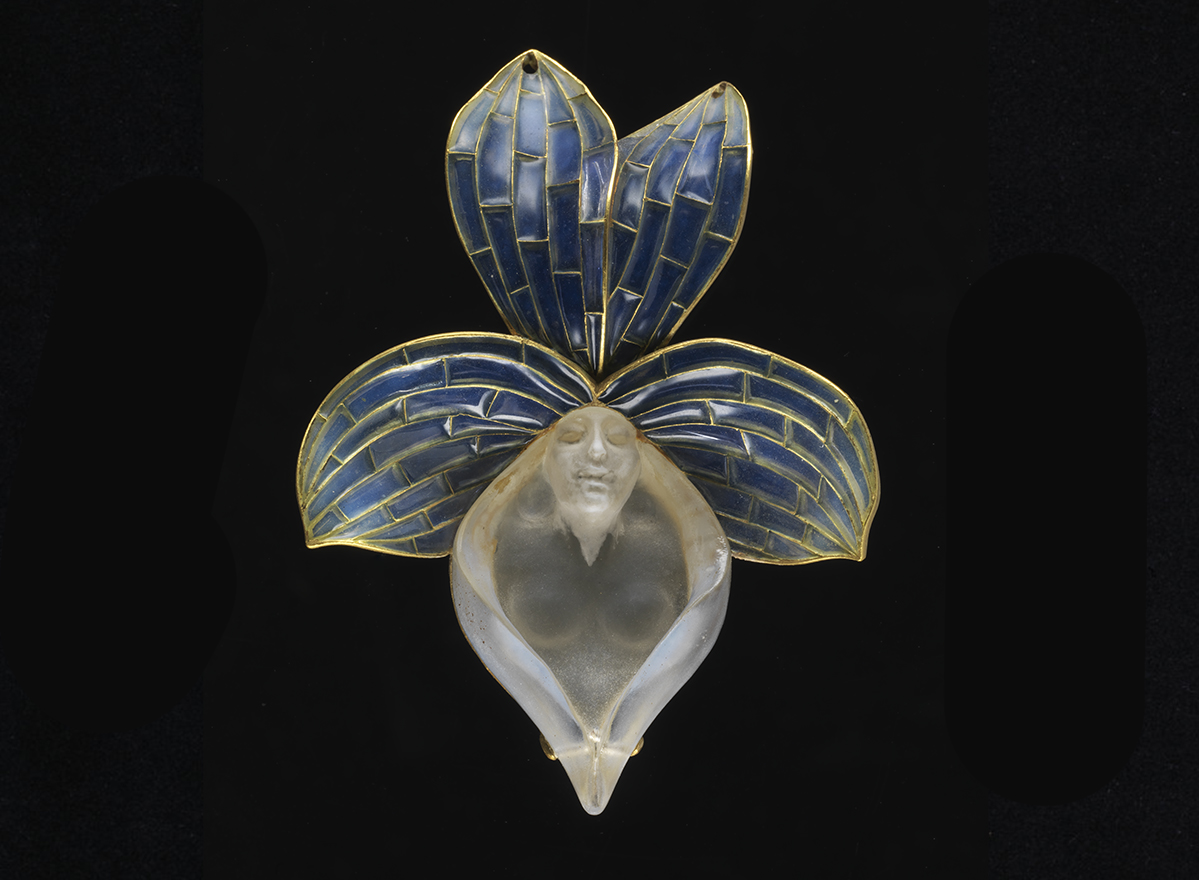
René Lalique, ‘Orchid’ pendant, c. 1900-1. Glass, gold and enamel. Founder’s Collection. Photo: Catarina Gomes Ferreira 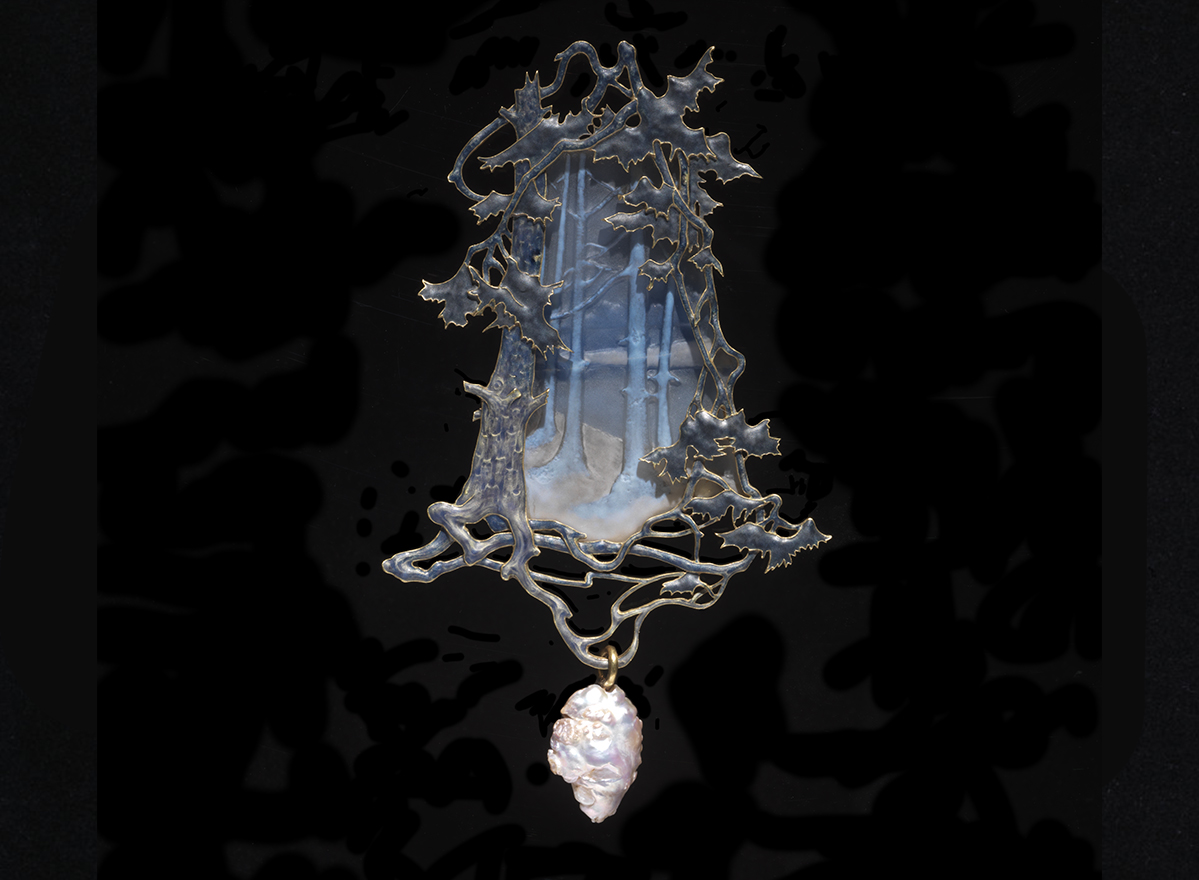
René Lalique, ‘Forest’ pendant, c. 1899‑ 1900. Glass, gold, enamel and baroque pearl. Founder’s Collection. Photo: Catarina Gomes Ferreira 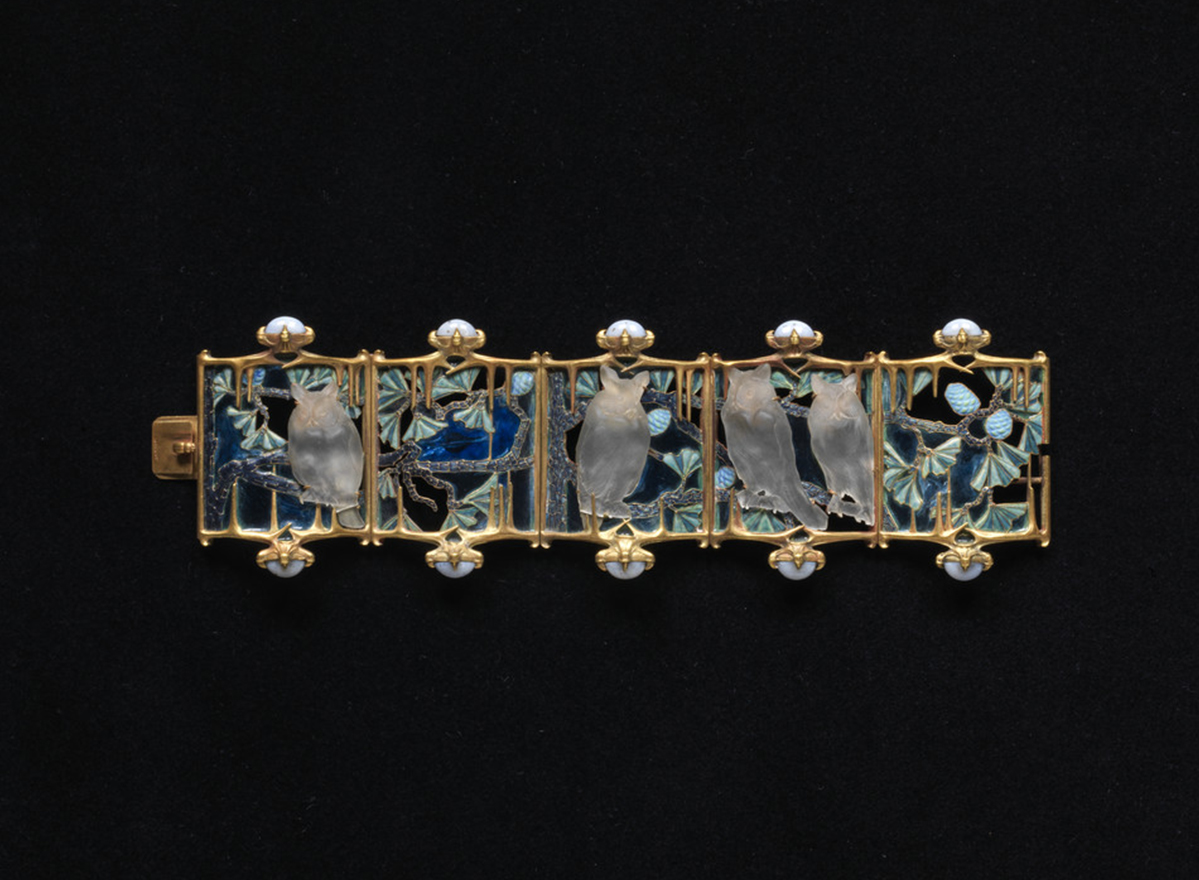
René Lalique, ‘Owls’ bracelet, c. 1900‑ 1. Glass, gold, enamel and chalcedony. Founder’s Collection. Photo: Catarina Gomes Ferreira 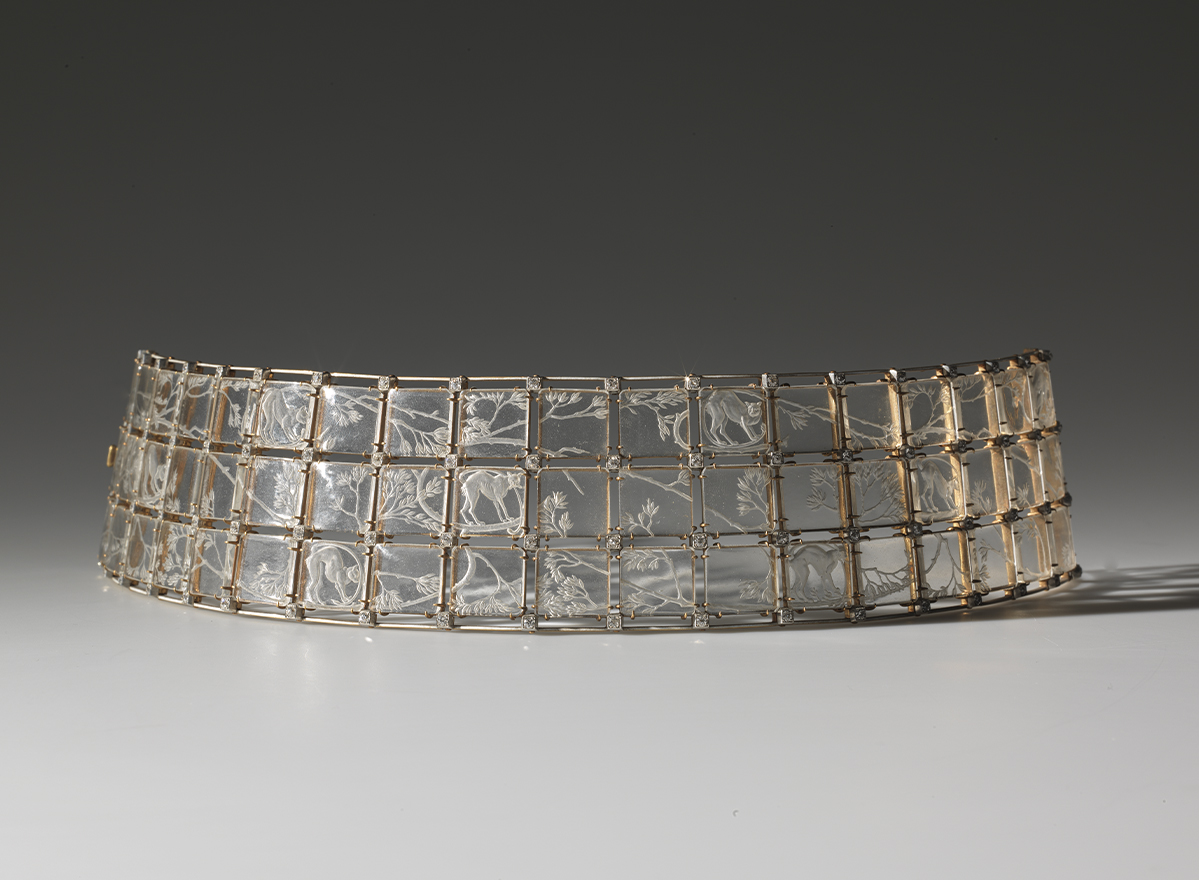
René Lalique, ‘Cats’ choker, c. 1906-8. Rock crystal, gold and diamonds. Founder’s Collection. Photo: Catarina Gomes Ferreira -
-
Lost-wax castings
In the late 19th century, Lalique purchased a property in Clairefontaine, where he set up a workshop to produce glass destined not just for costume jewellery but also for creating a large variety of pieces such as statuettes, lost-wax cast vases and other objects.
Lalique frequently used lost-wax casting, a technique derived from an old system of casting objects in bronze. The method involved moulding a piece from wax, then covering it in refractory clay. After being melted away, the wax left room for molten glass to be introduced. Once cool, the piece could be removed from the mould.
The artist used this complex and painstaking production technique to make his most elaborate creations, for demanding collectors who sought objects of prestige. Calouste Gulbenkian bought from Lalique more than ten of these rare, almost unique works, mostly vases, but also statuettes and other objects.

René Lalique, ‘Roses’ vase, 1921. Mould‑ blown lost wax cast glass with patina. Musée Lalique, Shai Bandmann & Ronald Ooi Collection. Photo: Studio Y. Langlois, Musée Lalique, Shai Bandmann & Ronald Ooi collection 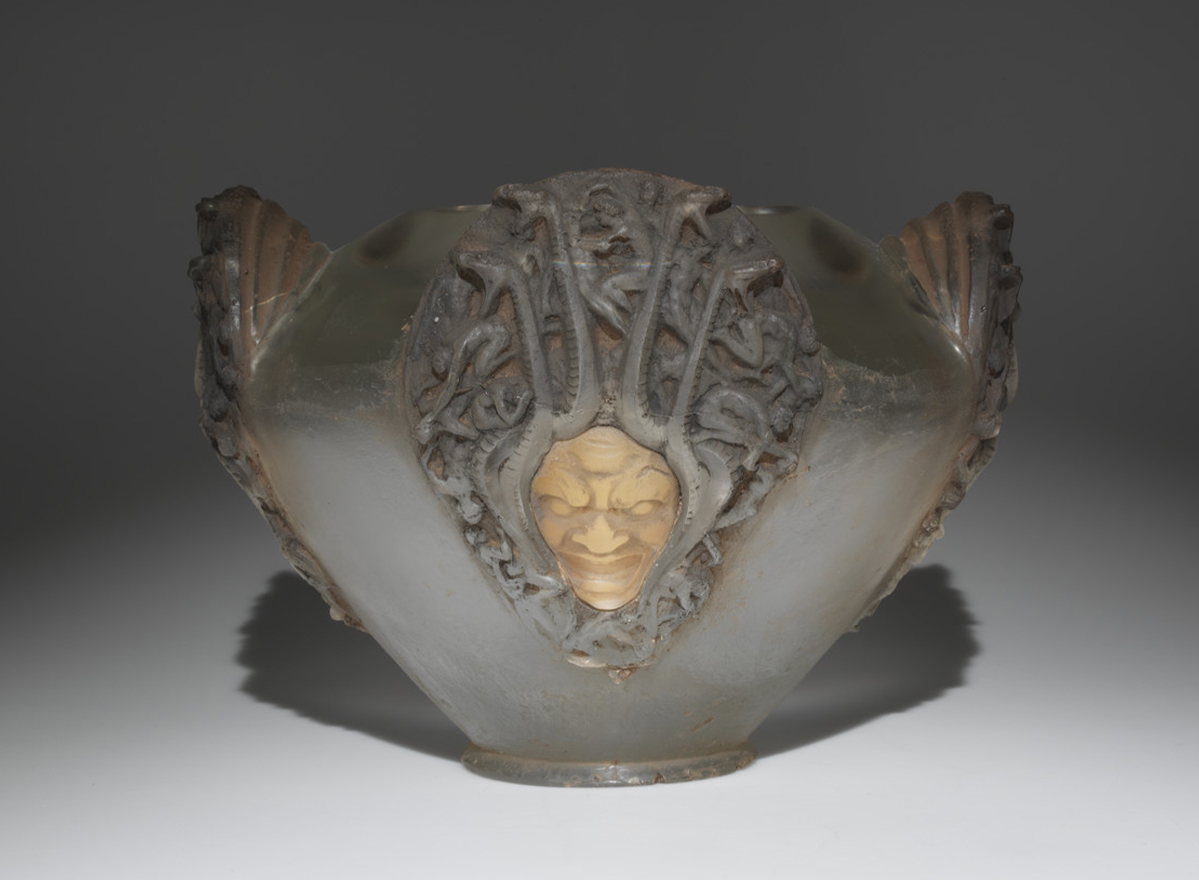
René Laliqeu, ‘Gorgons’ vase, 1913. Mould‑ blown lost wax cast glass with patina. Founder’s Collection. Photo: Catarina Gomes Ferreira 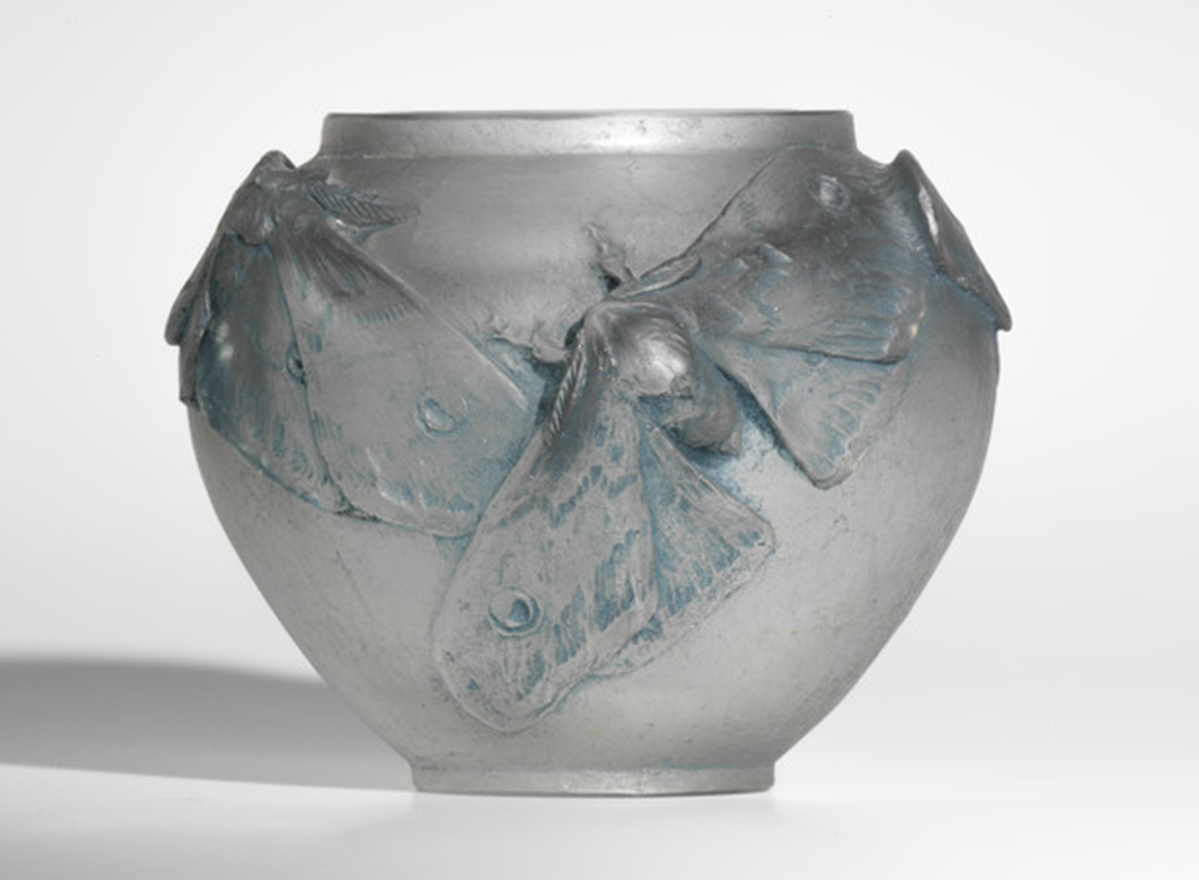
René Lalique, ‘Moths’ vase, 1913. Mould‑blown lost wax cast glass with patina. Founder’s Collection. Photo: Catarina Gomes Ferreira 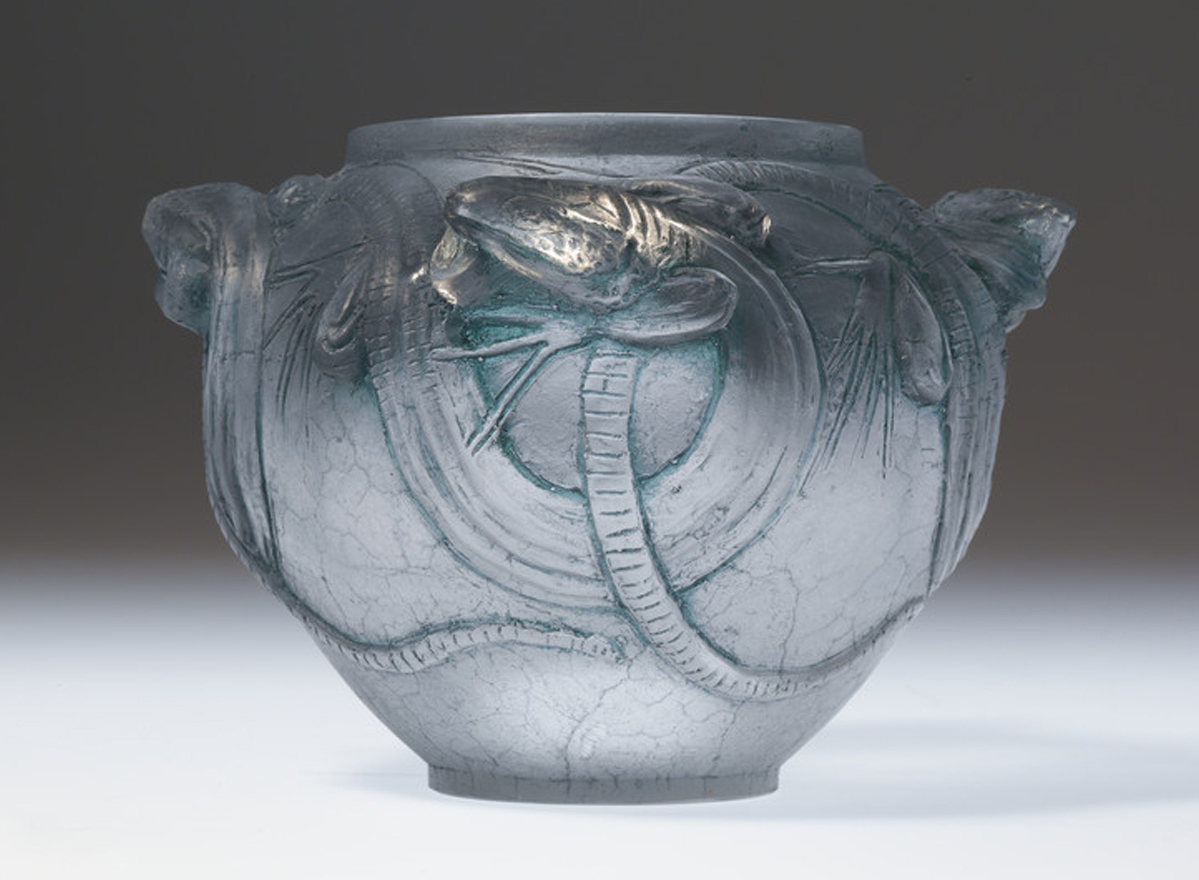
René Lalique, ‘Lizards’ vase, c. 1914. Mould‑ blown lost wax cast glass with patina. Founder’s Collection. Photo: Catarina Gomes Ferreira 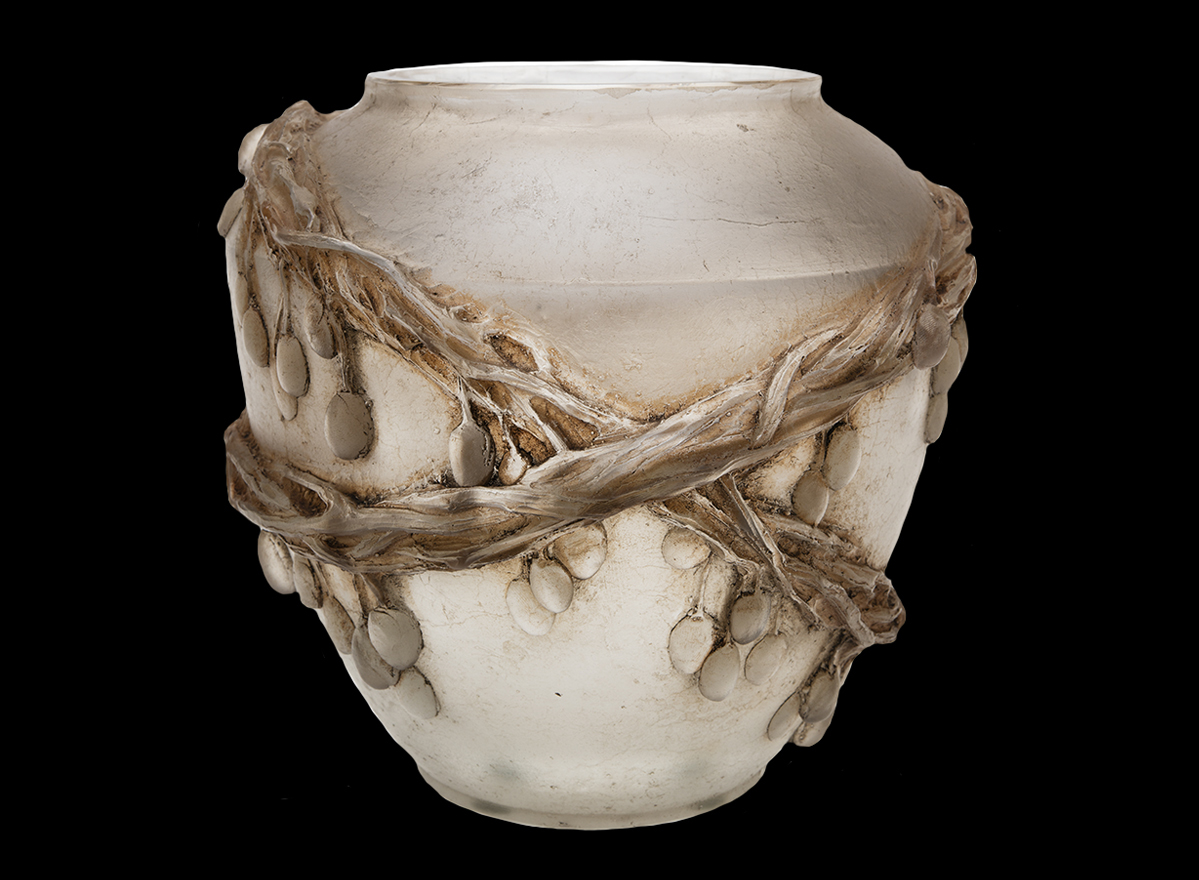
René Lalique, ‘Dogwood berries’ vase, c. 1914. Mould‑ blown lost wax cast glass with patina. Musée Lalique, Shai Bandmann & Ronald Ooi Collection. Photo: Studio Y. Langlois, Musée Lalique, Shai Bandmann & Ronald Ooi collection 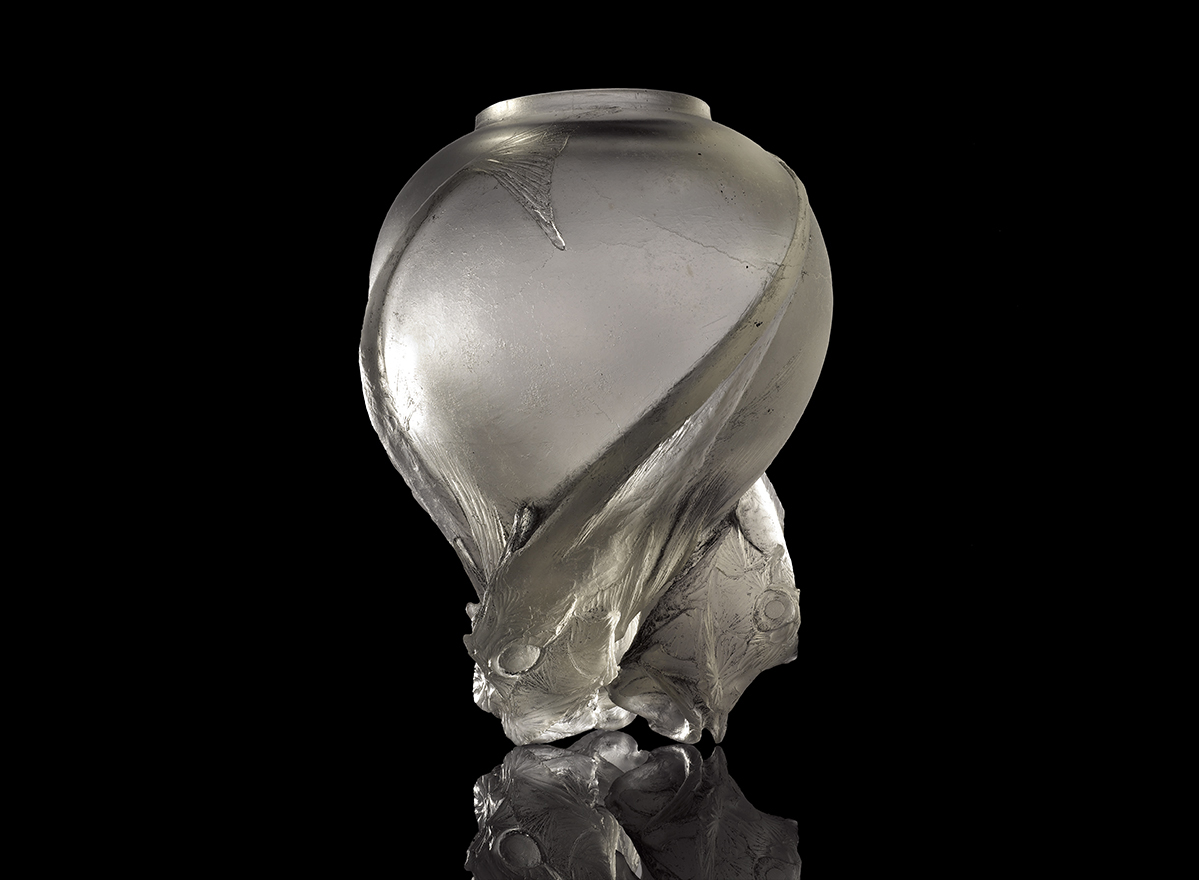
René Lalique, ‘Three gurnard fish’ vase, 1921. Mould‑ blown lost wax cast glass with patina. Musée Lalique, Shai Bandmann & Ronald Ooi Collection. Photo: Shuxiu Lin, Israël, Musée Lalique, Shai Bandmann & Ronald Ooi collection -
-
Industrial production
At the end of the First World War, Lalique bought a piece of land in Wingen-sur-Moder, in the Lower Rhine region, where he built a glass-making factory, with the support of the President of the Republic Alexandre Millerand, his friend and client. The founding of this factory was a decisive moment in his career: Lalique was able to expand his clientèle and become one of the most celebrated glass-makers at international level.
The factory, which officially began operating in 1922, allowed for the mass production of objects, which were accessible to a greater number of people. Both innovative and functional, these works sought to respond to the desires of middle class consumers.
Lalique’s venture to promote glass on a large scale contributed to a permanent change in the relationship between art and glass production. Lalique went from the status of ‘artisan-creator’ to that of ‘industrialist creator,’ inventing new methods and entrenching glass-making in the industrial history of the 20th century. Despite undergoing profound changes of style over time, the artist’s work always maintained its identity.

René Lalique, ‘Brambles’ vase, 1921. Mould‑ blown opalescente glass with patina. Founder’s Collection. Photo: Catarina Gomes Ferreira 
René Lalique, ‘Cluny’ vase, 1925. Mould‑ blown glass and bronze. Founder’s Collection. Photo: Catarina Gomes Ferreira 
René Lalique, ‘Danaïdes’ vase, 1926. Pressed glass. Musée Lalique Collection, Wingen-sur-Moder. Photo: Studio Y. Langlois, Musée Lalique, Wingen-sur-Moder 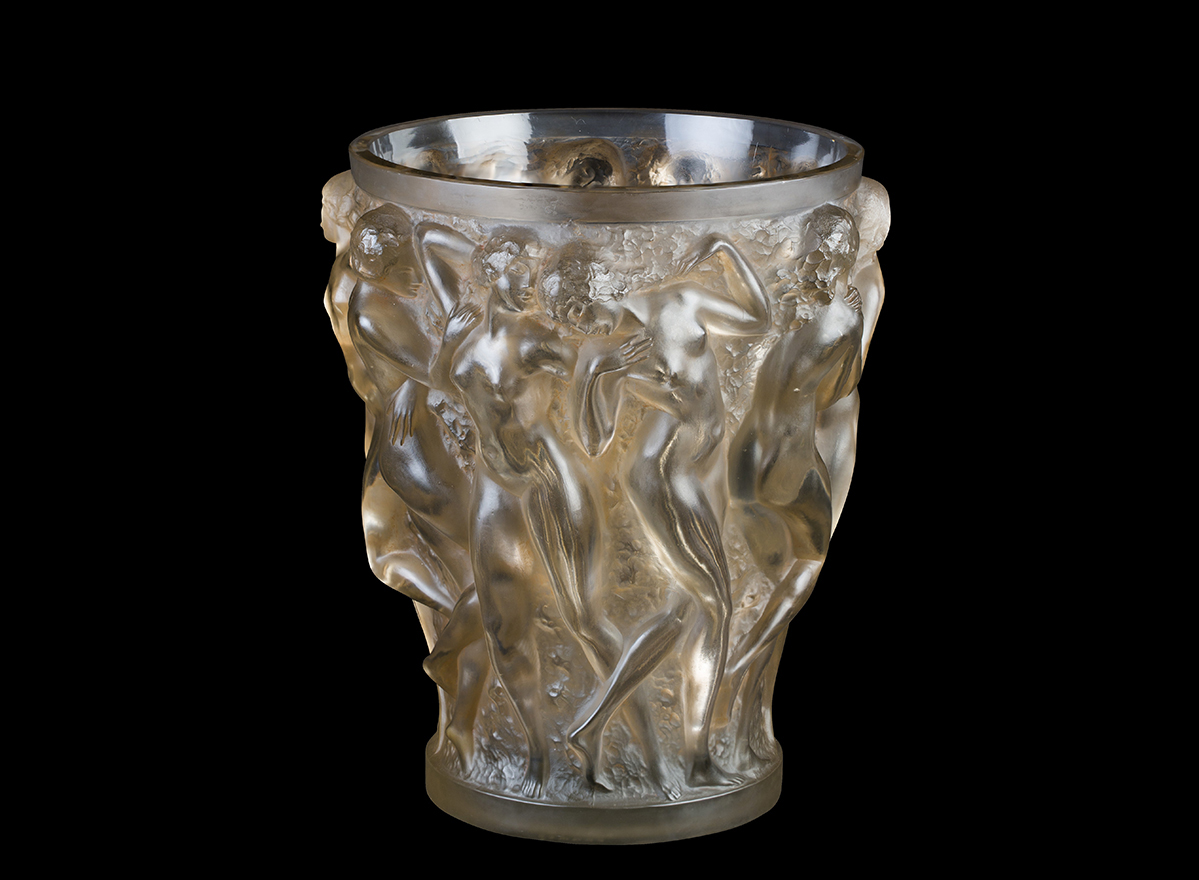
René Lalique, ‘Bacchantes’ vase, 1927. Pressed glass. Musée Lalique Collection, Wingen-sur-Moder. Foto: Karine Faby, Musée Lalique, Wingen-sur-Moder 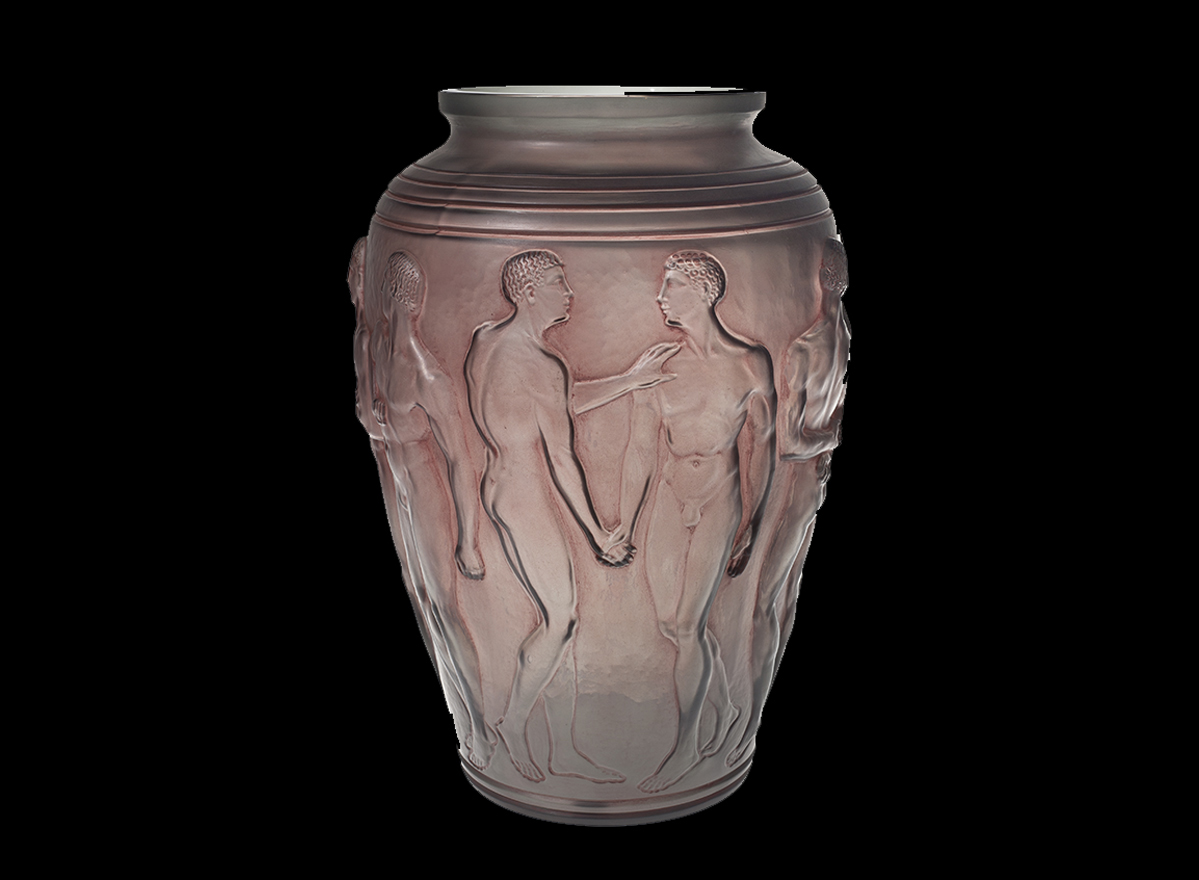
René Lalique, ‘Palestre’ vase, 1928. Mould‑ blown glass with patina. Musée Lalique, Shai Bandmann & Ronald Ooi Collection. Photo: Studio Y. Langlois, Musée Lalique, Shai Bandmann & Ronald Ooi collection 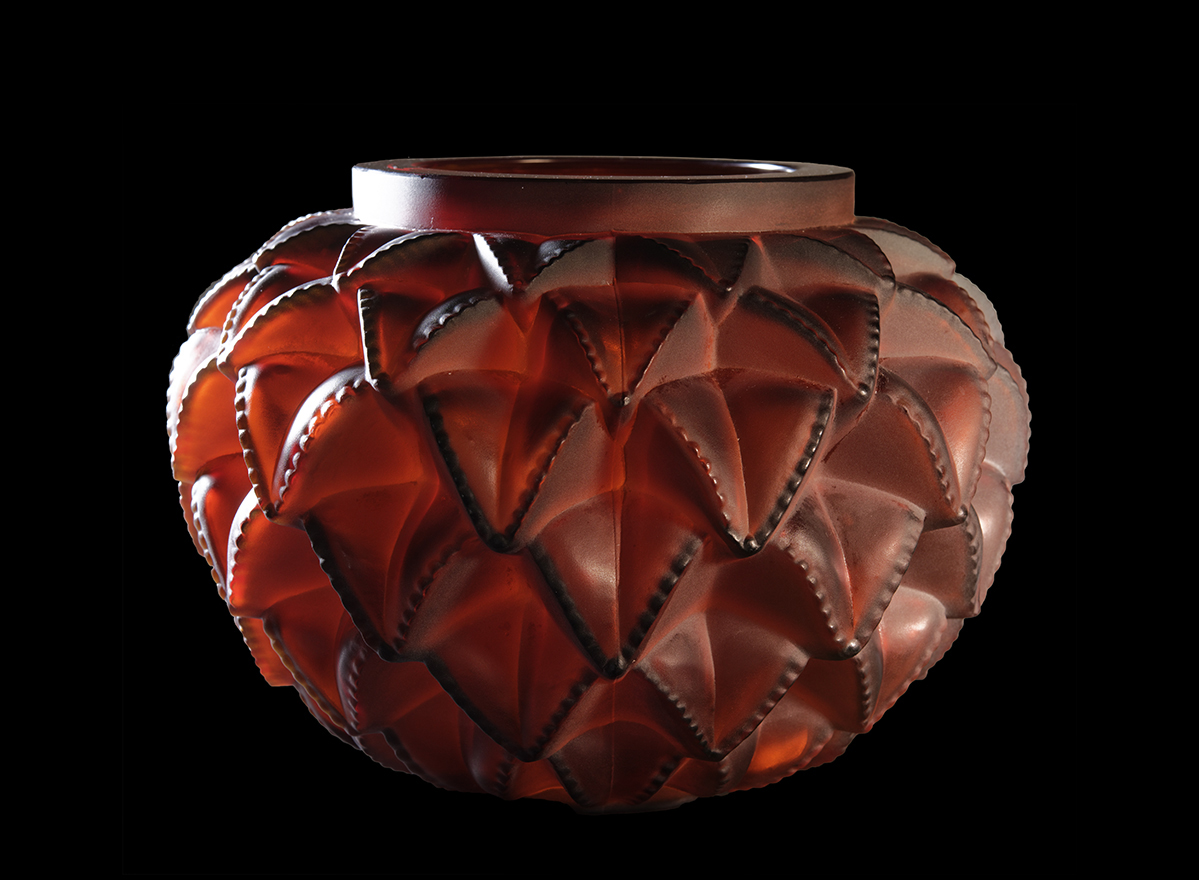
René Lalique, ‘Languedoc’ vase, 1929. Mould‑ blown glass. Musée Lalique, Shai Bandmann & Ronald Ooi Collection. Photo: Studio Y. Langlois, Musée Lalique, Shai Bandmann & Ronald Ooi collection -
-
Architecture
The Wingen-sur-Mer factory also allowed Lalique to broaden the horizons of his work and respond to commissions for modern architecture projects. In the early 20th century, Lalique moved into a hôtel particulier at no. 40 Cours-la-Reine, in Paris, personally taking care of the internal and external decoration of the building, the façade of which included glass panels decorated with plant motifs.
The success of this undertaking opened the way for experimentation and Lalique continued to use glass in architecture. The commercial partnership he developed with the perfumer François Coty culminated in a bold decorative project for the façade of the American branch of the latter’s shop on 5th Avenue, New York, for which Lalique designed, at the time of its renovation, glass windows with poppy motifs.
At the start of the 1930s, Lalique was involved in decorating the world’s largest ocean liner, the Normandie, creating glass wall coverings, as well as being responsible for the lighting elements, for which he designed chandeliers and large appliques. In 1932, the artist worked on the installation of six glass fountains at the Rond-Point on the Champs-Élysées, designing two models with dove motifs and with squirrels and pine cones.
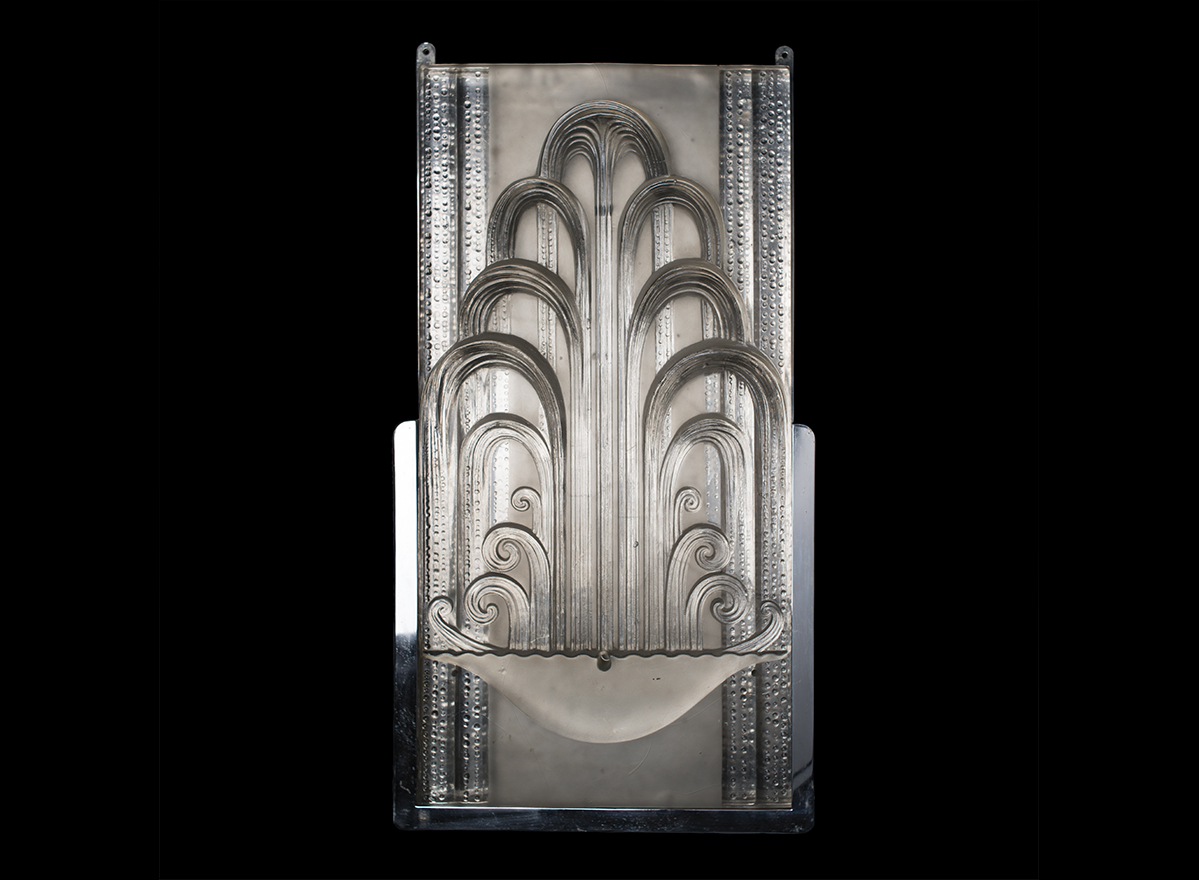
René Lalique, ‘Glassblower’ decorative panel, 1925. Pressed glass with patina. Musée Lalique, Shai Bandmann & Ronald Ooi Collection. Photo: Studio Y. Langlois, Musée Lalique, Shai Bandmann & Ronald Ooi collection 
René Lalique, ‘Glassblower’ decorative panel, 1925. Pressed glass with patina. Musée Lalique, Shai Bandmann & Ronald Ooi Collection. Photo: Studio Y. Langlois, Musée Lalique, Shai Bandmann & Ronald Ooi collection 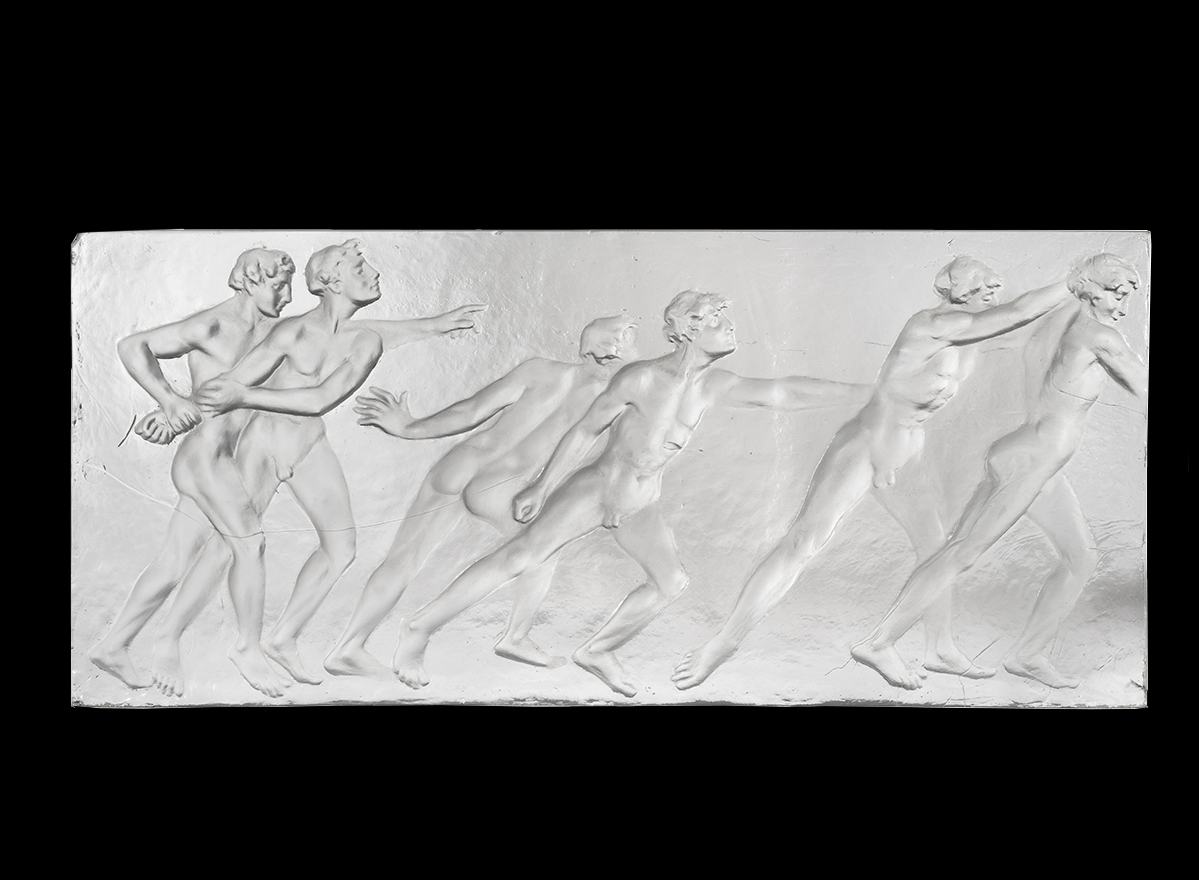
René Lalique, ‘Athletes’ decorative panel, c. 1902. Pressed glass with patina. Musée Lalique, Shai Bandmann & Ronald Ooi Collection. Photo: Karine Faby, Musée Lalique, Shai Bandmann & Ronald Ooi collection: 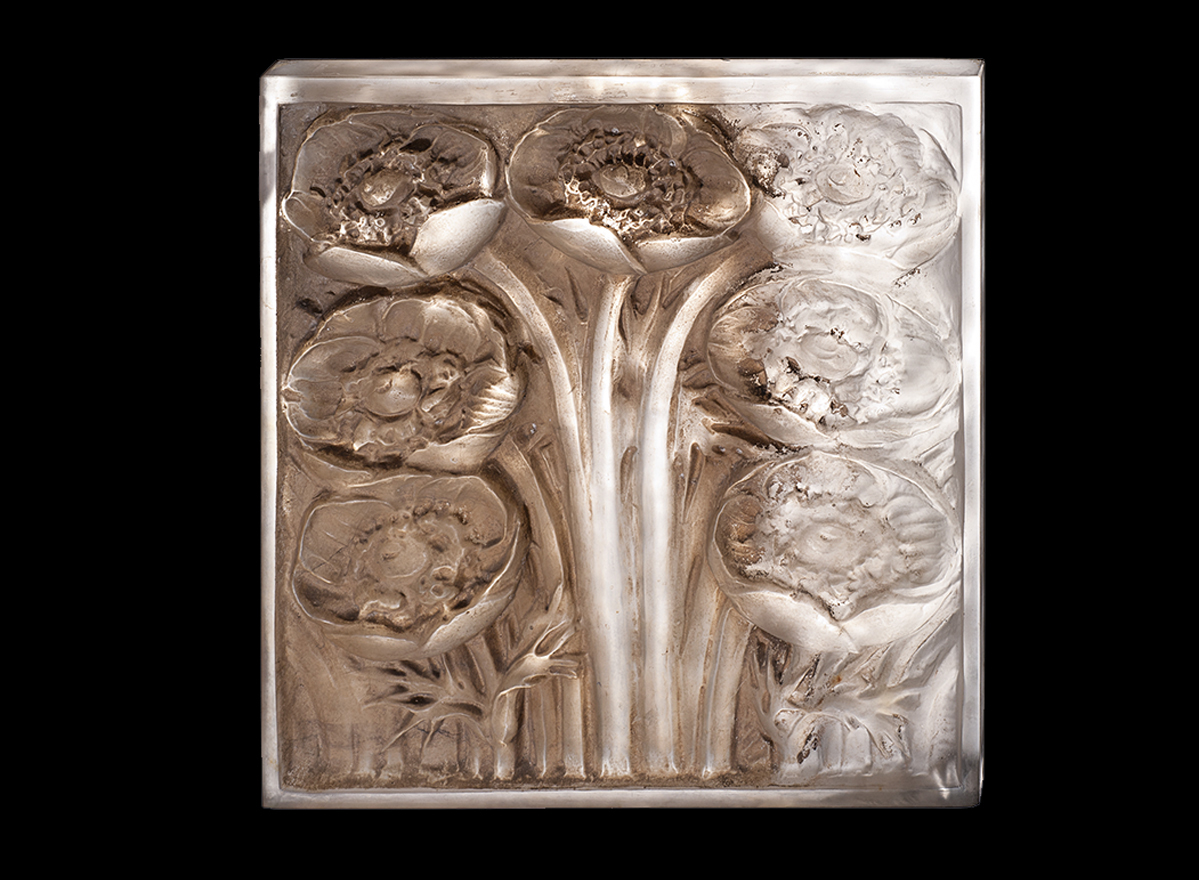
René Lalique, ‘Poppies’ decorative panel, 1912. Pressed glass with patina. Musée Lalique, Shai Bandmann & Ronald Ooi Collection. Photo: Studio Y. Langlois, Musée Lalique, Shai Bandmann & Ronald Ooi collection -
-
Design
A period of great prosperity followed the First World War, with an increase in consumerism and the development of a modern taste. The purchase of objects for individual use marked the next few decades, from dressing tables and jewellery cases to ashtrays and car mascots – car mascots becoming fashionable thanks to the Prince of Wales, for whom Lalique created the Greyhound.
Lalique’s versatility was inexhaustible. It was at this time that he began to introduce coloured glass to his regular work, creating objects in various sizes and with great originality. The artist’s favourite themes – the female form, nature (flora and fauna) and antiquity – were common in his work and can be seen in various types of objects.
The 1925 International Exhibition of Modern Decorative and Industrial Arts played a fundamental role in the link between art and industry, promoting consumerism as a way of achieving personal satisfaction. The event saw the participation of the biggest names of the day, including Lalique, who presented an Art Deco style pavilion, the decoration of which featured a lot of glass, and worked on diverse projects within the context of the exhibition.
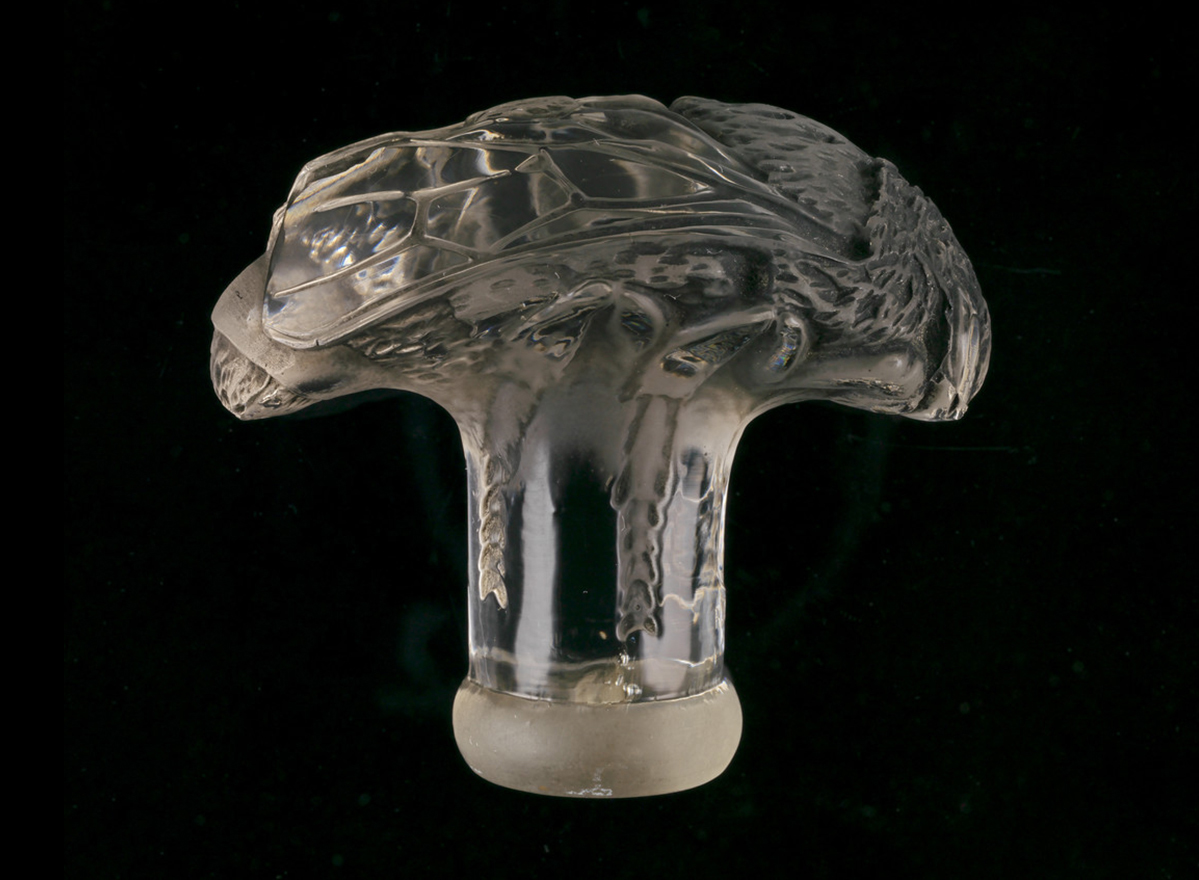
René Lalique, ‘Drone’ seal, 1910. Mould‑ blown and pressed glass with patina. Founder’s Collection. Photo: Catarina Gomes Ferreira 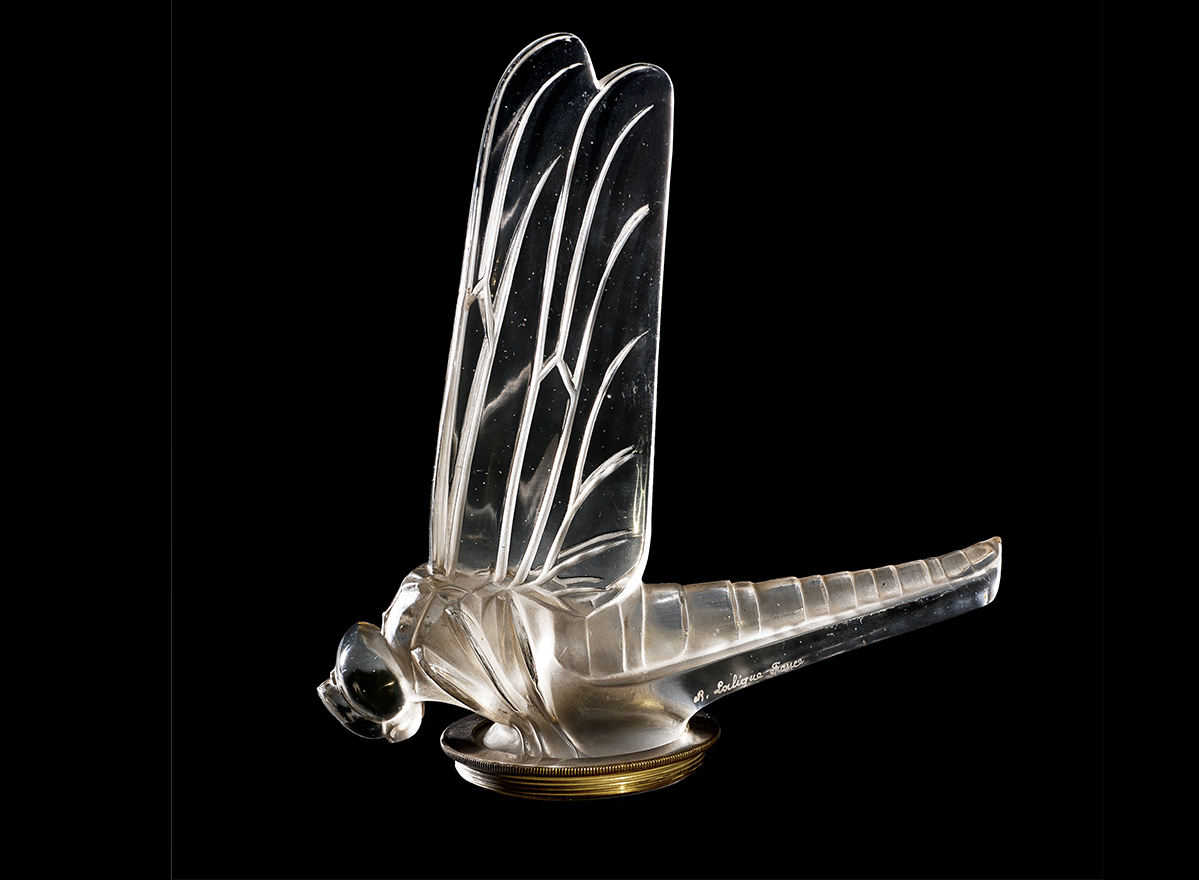
René Lalique, ‘Greyhound’ car mascot, 1928. Pressed glass and metal. Musée Lalique, Private collection. Foto: Karine Faby, Private collection 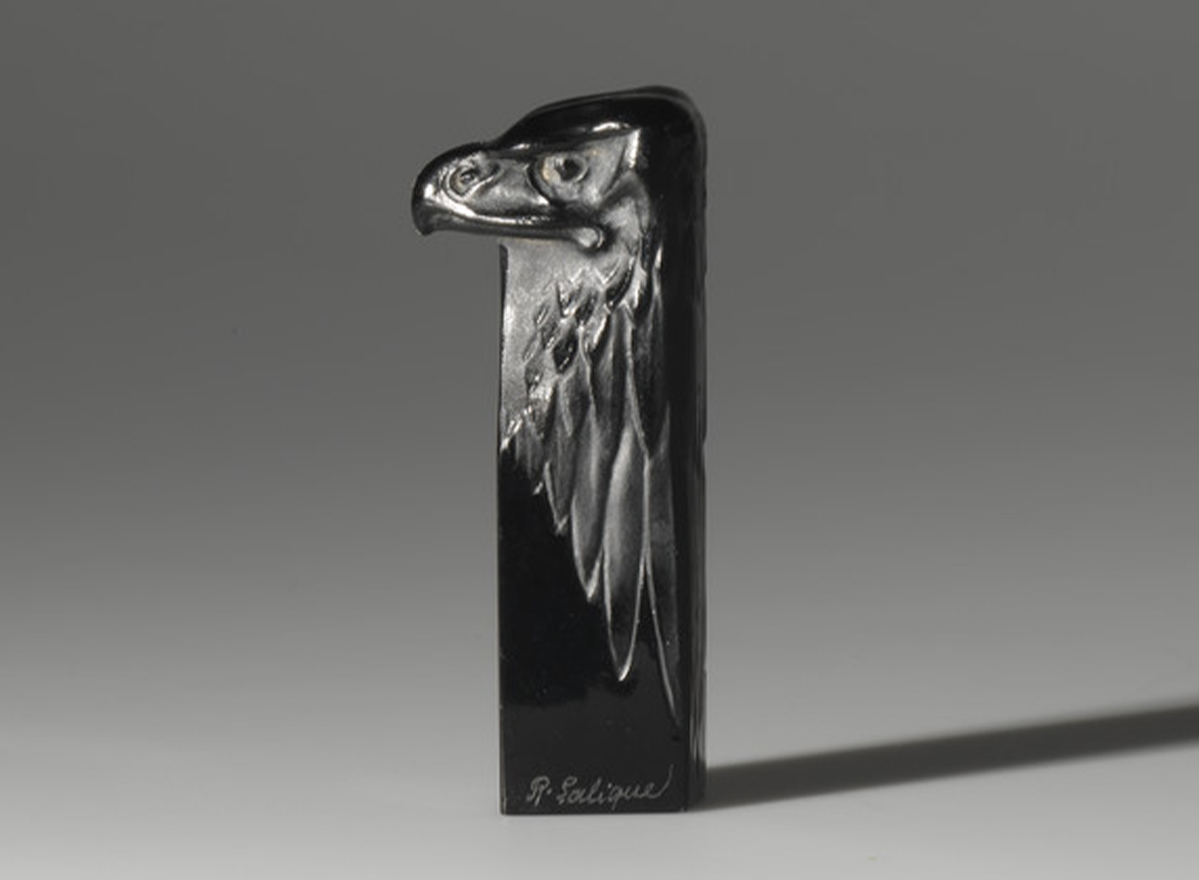
René Lalique, ‘Head of eagle’ seal, 1911. Mould‑ blown and pressed glass with patina. Founder’s Collection. Photo: Catarina Gomes Ferreira 
René Lalique, ‘Greyhound’ car mascot, 1928. Pressed glass and metal. Musée Lalique, Private collection. Foto: Karine Faby, Private collection 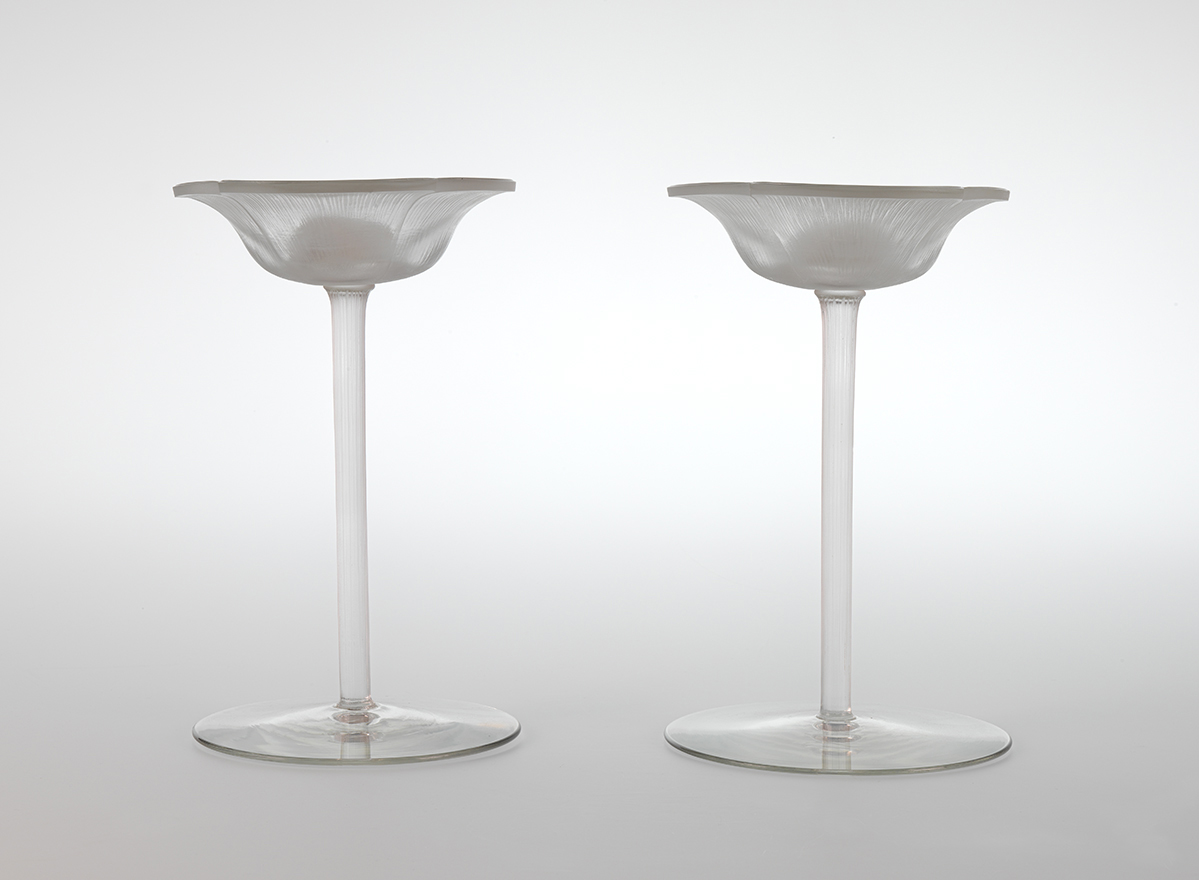
René Lalique, ‘Poppies’ candlesticks, 1922. Mould‑ blown and pressed glass with patina. Founder’s Collection. Photo: Catarina Gomes Ferreira 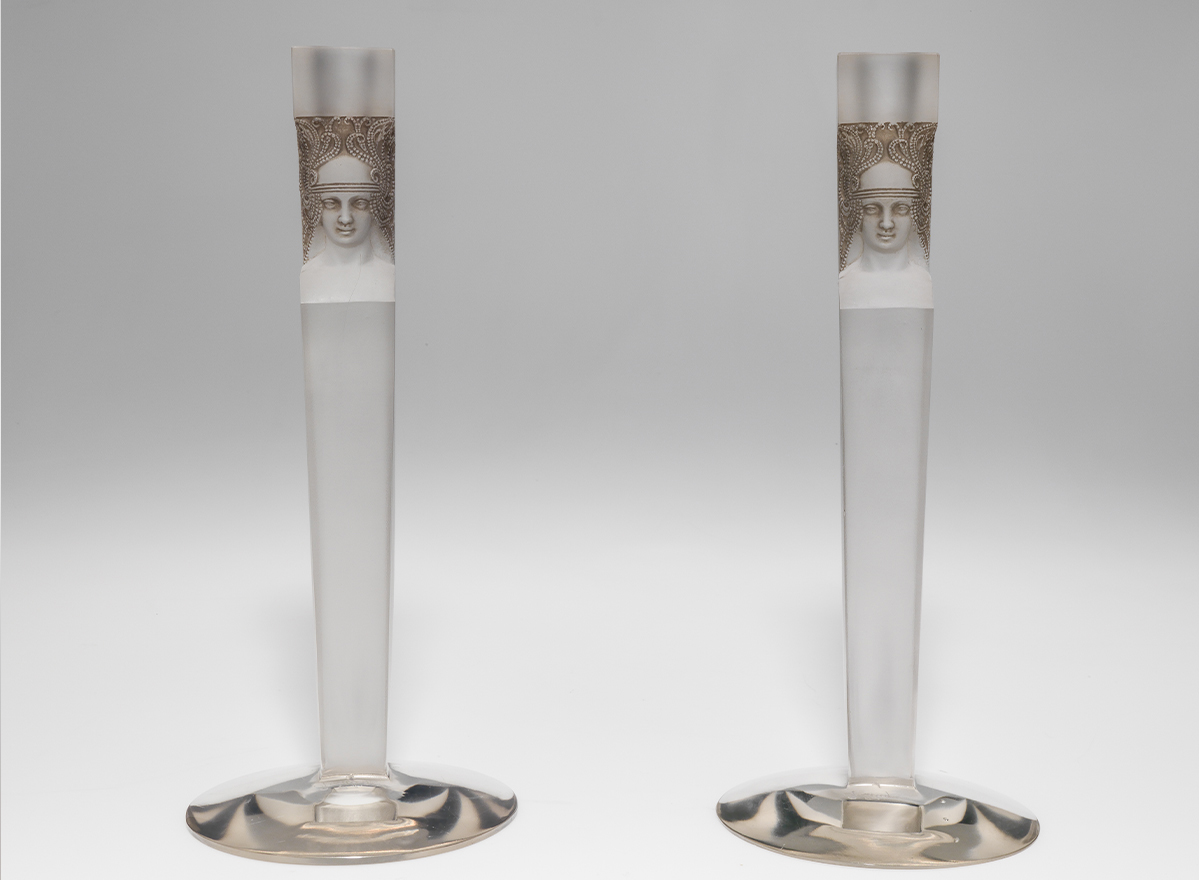
René Lalique, ‘Caryatids’ candlesticks, 1923. Pressed glass with patina. Photo: Catarina Gomes Ferreira -
-
‘Objets d’Art’
Lalique’s interest in glass as a material of creation developed very early in his career. By 1890, the artist had already set up a workshop for the purpose of experimenting with glass in his studio on Rue Thérèse, in Paris.
Examples of work from this period include free-standing statuettes and glass objects with silver mounts, such as chalices and jugs, among others, some of which were presented at the Universal Exposition of 1900.
The technique he used to create these pieces was based on the bond between glass and gold and silver work, which complemented the connection Lalique had already developed between glass and jewellery. Made in the early 20th century, the monumental glass and silver centrepiece Female Figure is one of the most significant works in this group, along with the Thistles jug and the Snakes sugar bowl.
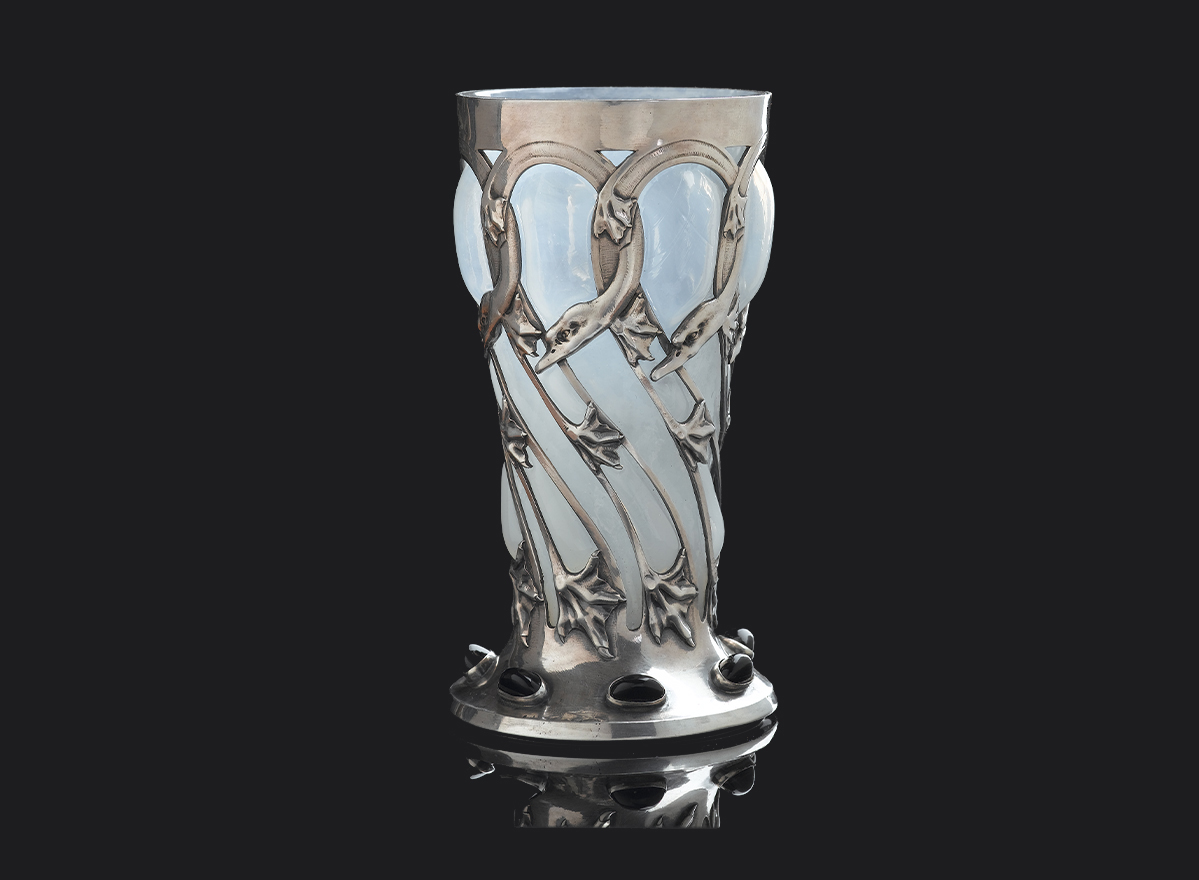
René Lalique, ‘Swans’ vase, c. 1896‑8. Mould-blown glass and silver. Musée Lalique, Shai Bandmann & Ronald Ooi Collection. Foto: Rami Salomon and Kineret Levy Studio, Musée Lalique, Shai Bandmann & Ronald Ooi collection 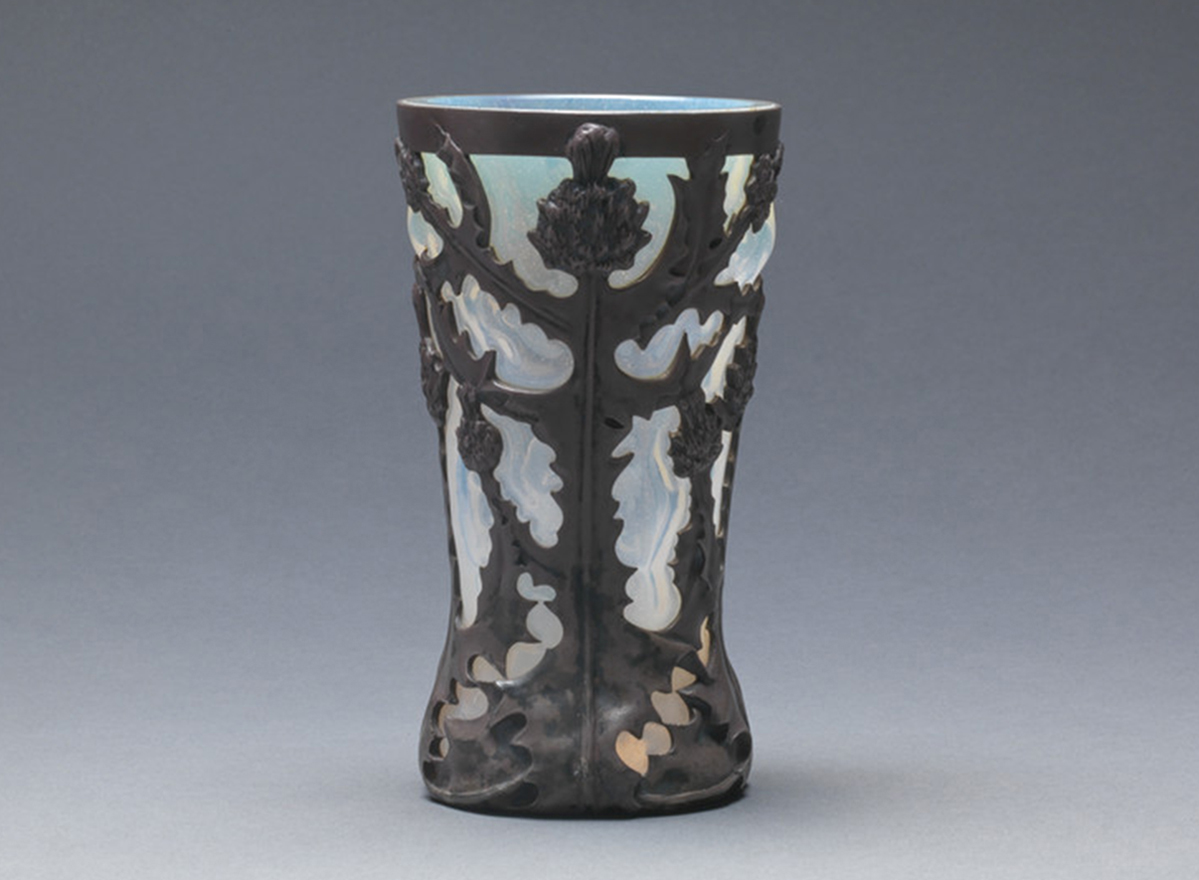
René Lalique, ‘Thistles’ vase, c. 1898‑ 1900. Mould-blown opalescent glass and silver. Founder’s Collection. Photo: Catarina Gomes Ferreira 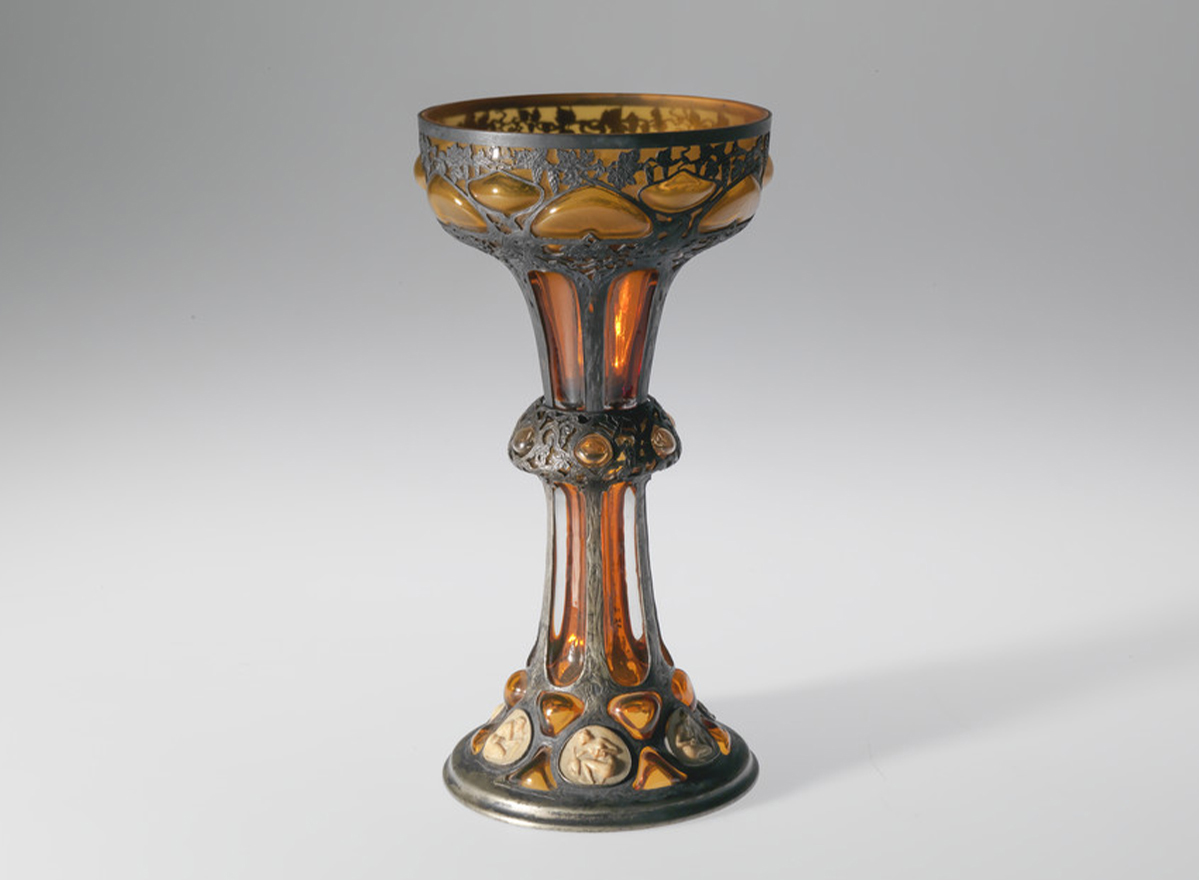
René Lalique, ‘Vine motifs and figures’ goblet, c. 1899‑ 1901. Mould‑ blown glass, silver and bronze. Founder’s Collection. Photo: Catarina Gomes Ferreira 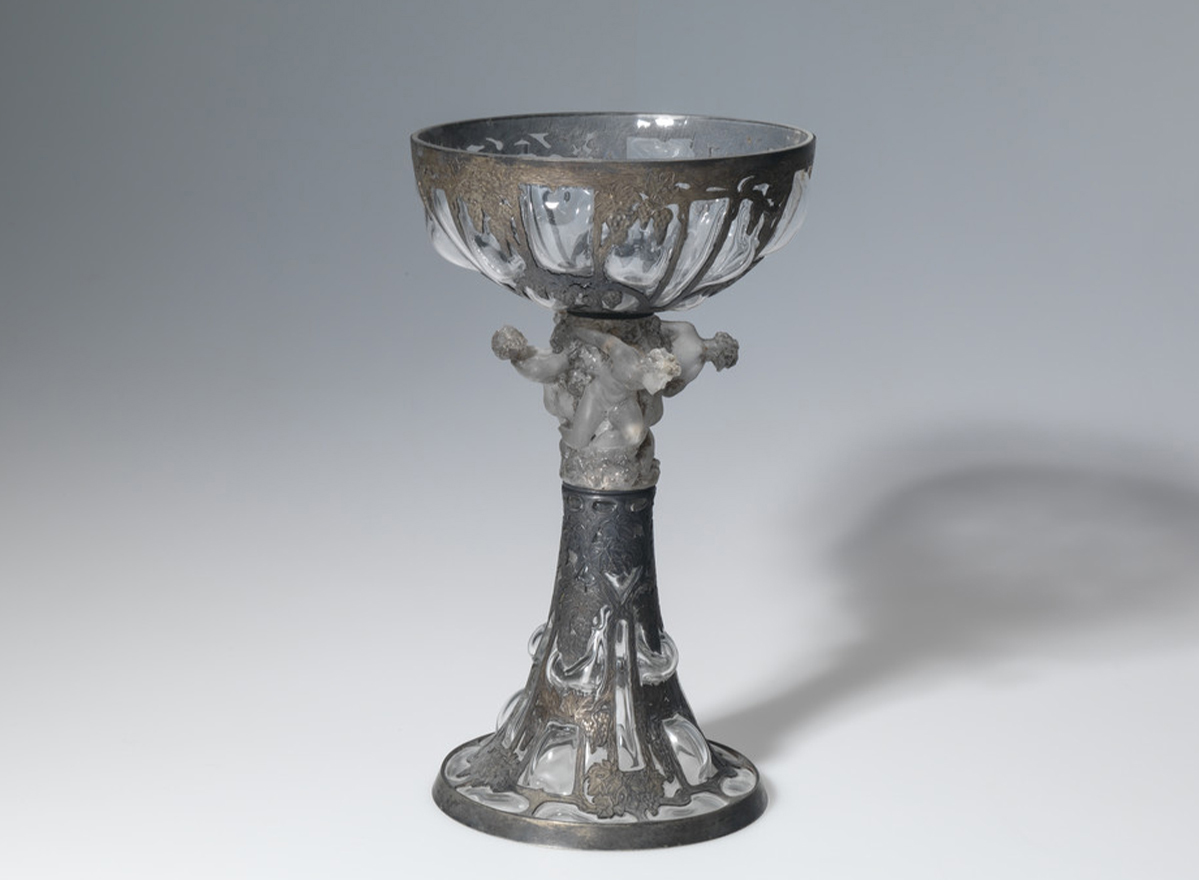
René Lalique, ‘Grapevine’ goblet, 1898‑ 1900. Glass, metal (nickel), ivory and enamel. Founder’s Collection. Photo: Catarina Gomes Ferreira 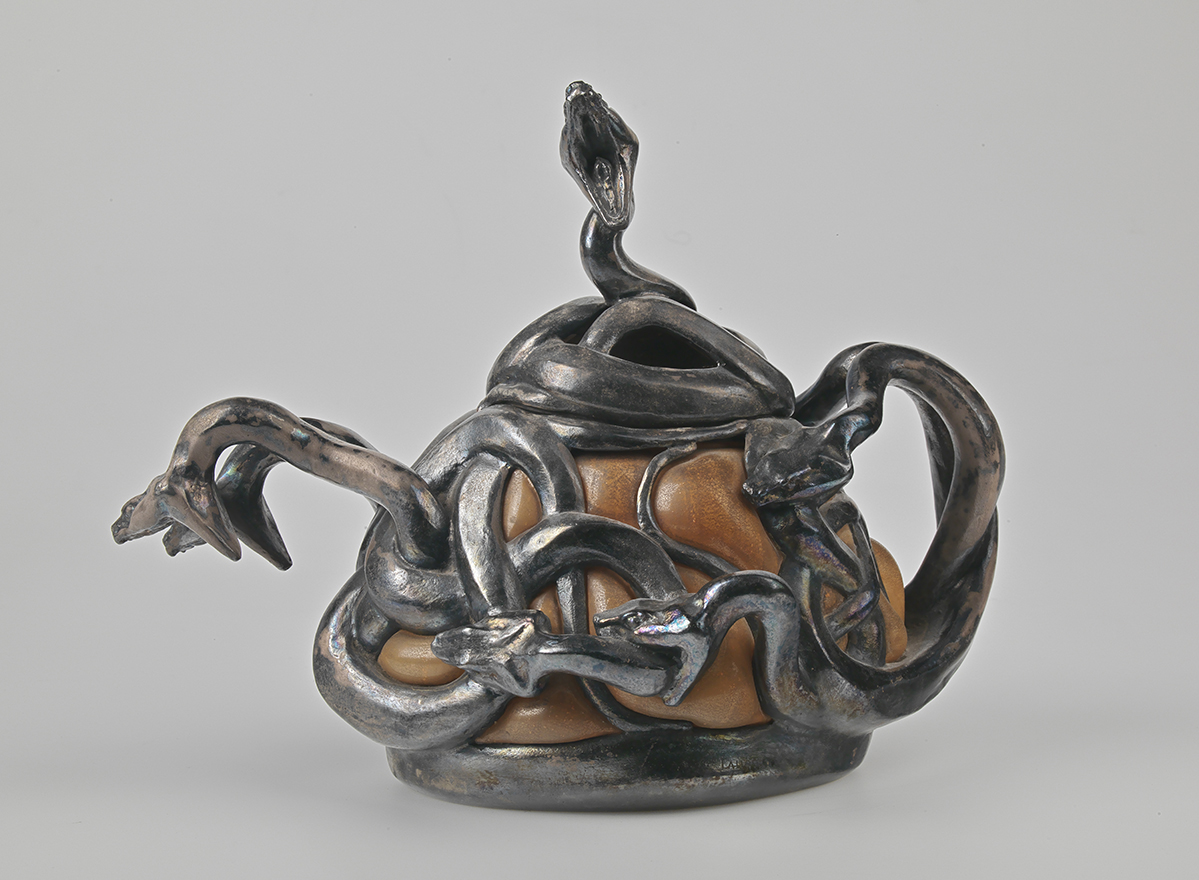
René Lalique, ‘Serpents’ sugar bowl, c. 1897-1900. Mould-blown glass and silver. Founder’s Collection. Photo: Catarina Gomes Ferreira 
René Lalique, ‘Female figure’ centrepiece, c. 1903‑ 5. Mould-blown glass and silver. Photo: Catarina Gomes Ferreira -
-
The invention of modern perfume
In 1907, René Lalique met perfumer François Coty, the father of modern perfume, who invited him to design first the labels and later the bottles for his fragrances. It was this relationship with Coty that sparked Lalique’s interest in mass production: long before opening his factory, the artist rented a space in Combs-la-Ville, in the outskirts of Paris, to mass produce his objects.
The partnership between these two men revolutionised the perfume industry and made a mark on Lalique’s career. The artist designed more than 20 bottles, vaporisers and boxes for Coty. In order to respond more quickly to the rapid growth in demand, Lalique registered a patent for the production of flasks, bottles and jars, which allowed for more regular and precise manufacture.
Lalique also produced bottles for other famous houses, such as Worth, Roger & Gallet, Guerlain, Lubin, Nina Ricci, D’Orsay, D’Héraud and Rochas. Lalique was highly skilled at creating designs adapted to each perfume, attributing an image to each of the fragrances.
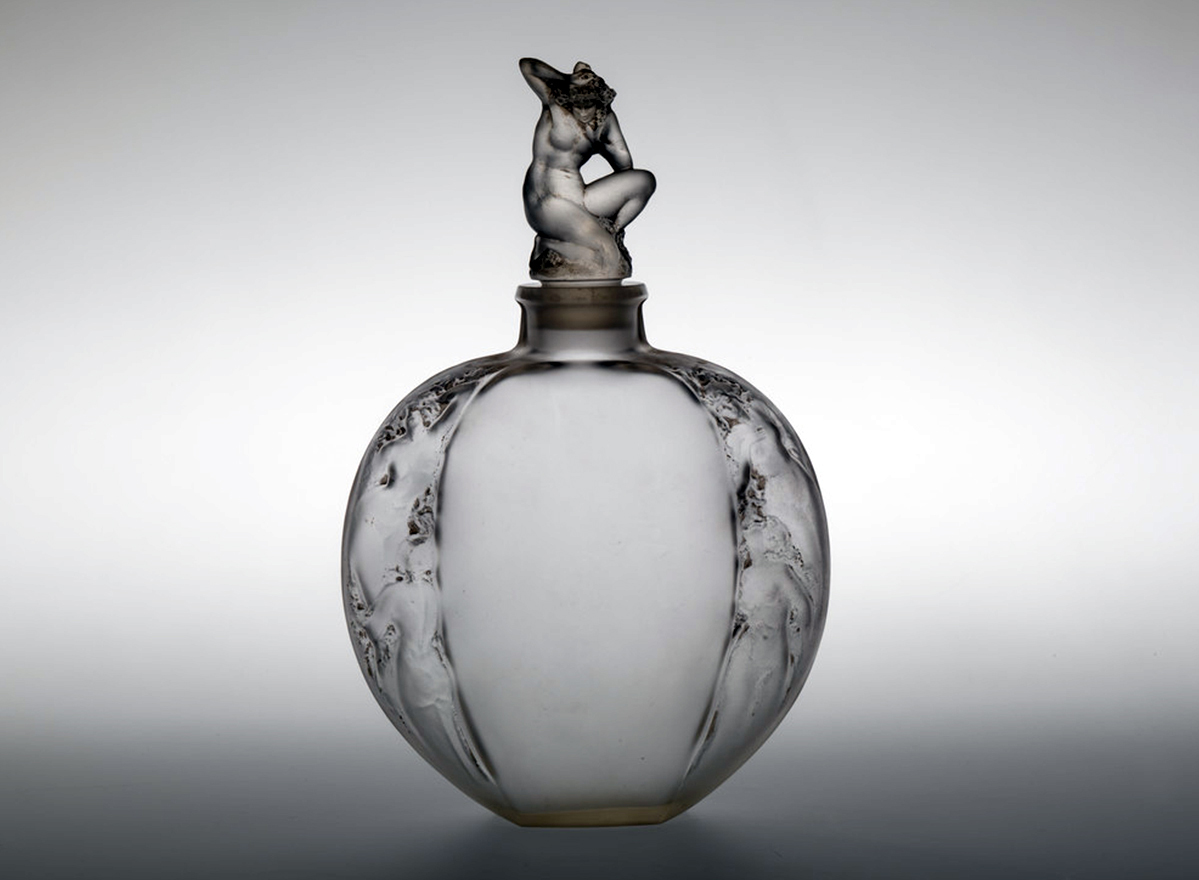
René Lalique, ‘Sirens’ perfume bottle, 1920. Mould‑ blown opalescent glass with patina. Founder’s Collection. Photo: Catarina Gomes Ferreira 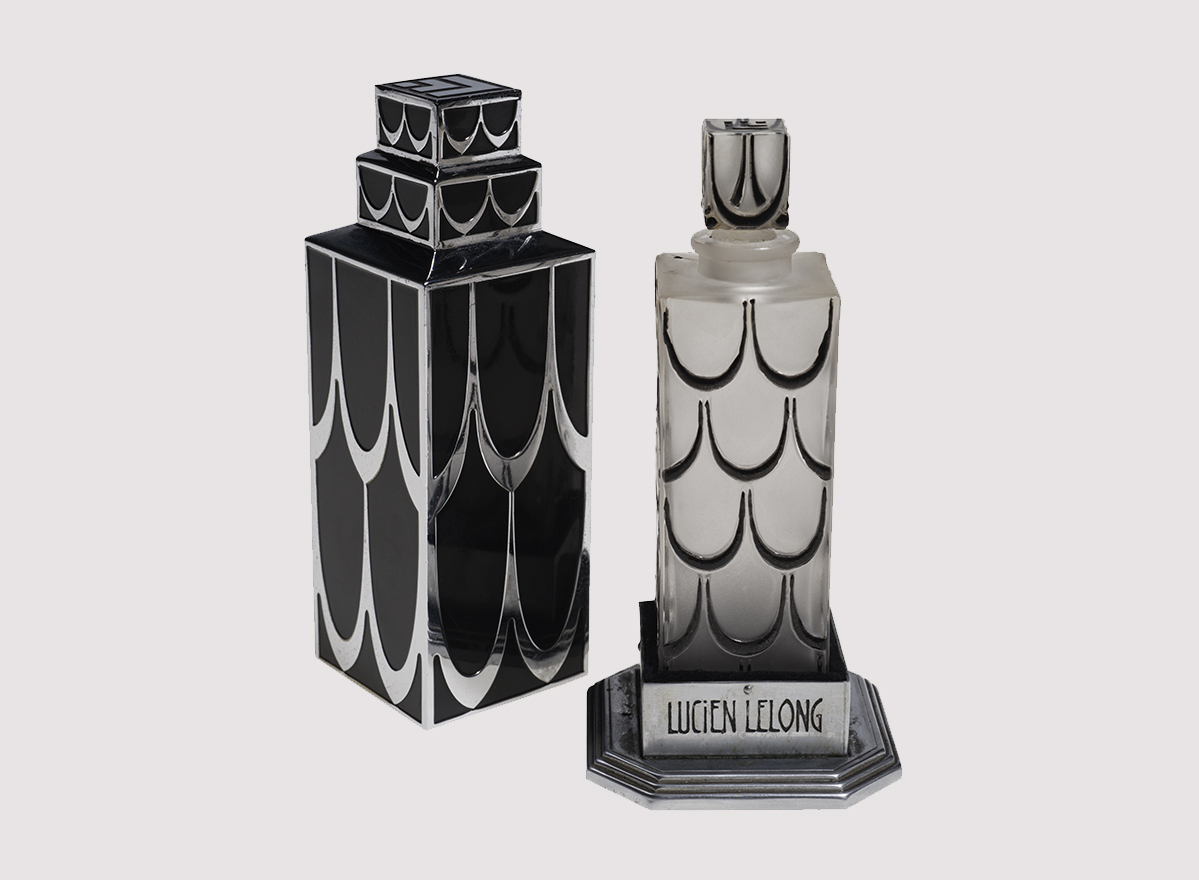
René Lalique, ‘Lucien Lelong’ perfume bottle, 1929. Mould‑ blown glass and enamel. Musée Lalique, Benjamin Gaustaud Collection, Paris. Photo: Studio Y. Langlois, Musée Lalique, Benjamin Gastaud collection, Paris 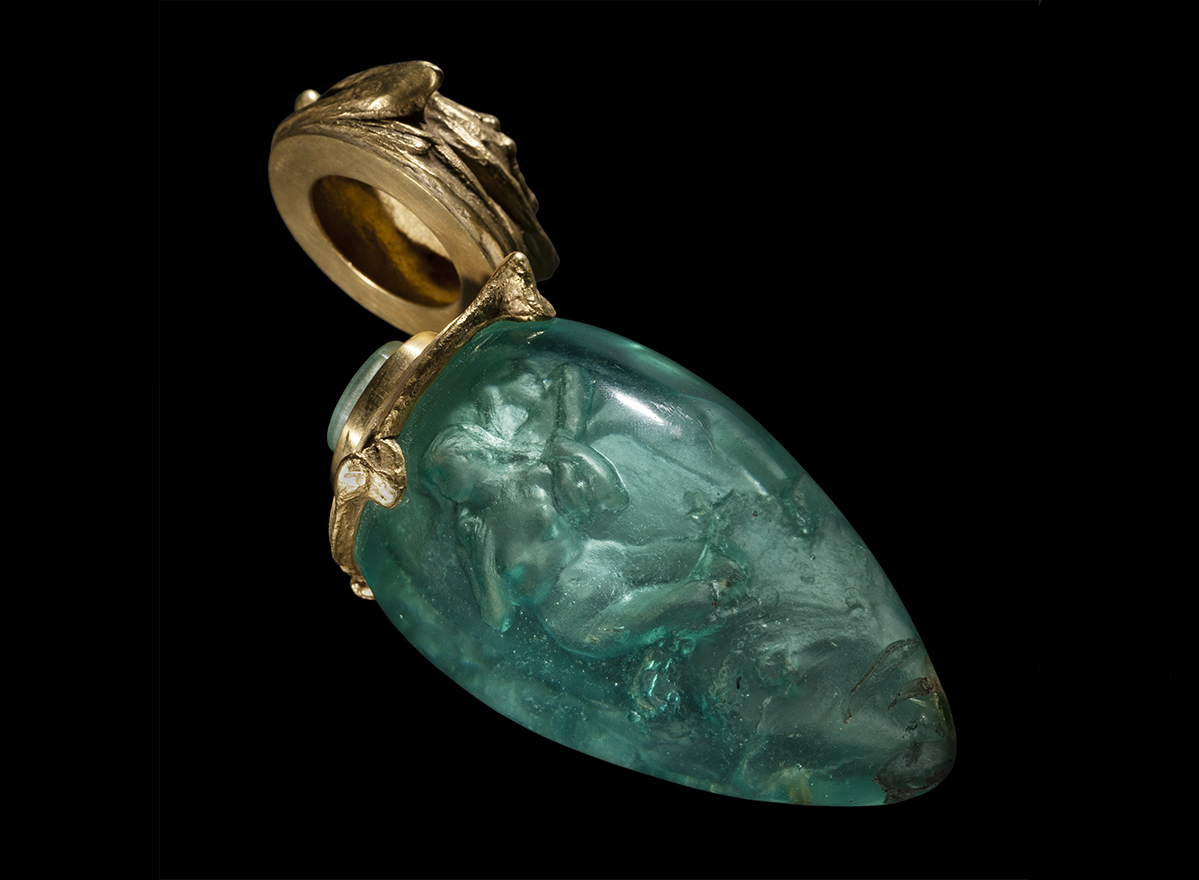
René Lalique, ‘Sirens’ perfume bottle, c. 1905. Mould‑ blow lost wax cast glass and gold. Musée Lalique, Shai Bandmann & Ronald Ooi Collection. Photo: Studio Y. Langlois, Musée Lalique, Shai Bandmann & Ronald Ooi collection 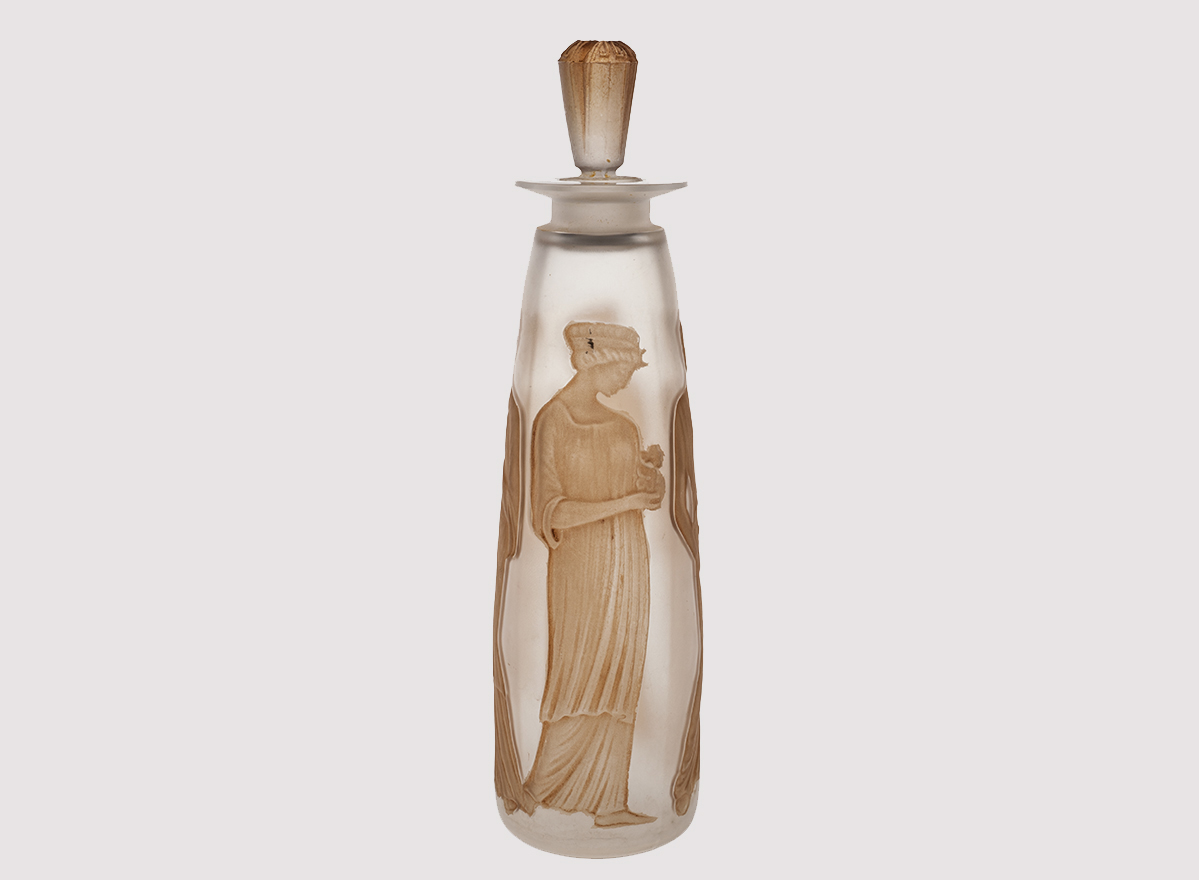
René Lalique, ‘Ancient amber’ perfume bottle, 1910. Mould‑ blown glass with patina. Musée Lalique Collecion, Wingen-sur-Moder. Photo: Studio Y. Langlois, Musée Lalique, Wingen-sur-Moder -
Complementary Programs
Visitas digitais para academias, universidades seniores e grupos particulares
Mediante marcação prévia a partir de 06 de abril
Marcações
Mais informações
[email protected]
